Michael Rosengart, CPT, CES, CSCS outlines the importance of assessing movements and shares the Basic Assessments and Movement Evaluations for runners and athletes that run from the PreHab Exercise Book for Runners, Fourth Edition.
Start Right
The first step to any effective training or prehab/rehab program is to evaluate the athlete or client in regards to Movement Quality and biomechanics. When it comes to prescribing exercises and designing workouts, if you are not assessing, you are only guessing!
The first step to any effective training or prehab/rehab program is to evaluate the athlete or client in regards to Movement Quality and biomechanics. When it comes to prescribing exercises and designing workouts, if you are not assessing, you are only guessing!
Use these basic alignment assessments and movement evaluations to create an effective PreHab Exercise program for your runners or athletes that run.
In The PreHab Exercise Book for Runners – Fourth Edition, author Michael Rosengart introduced the following Assessments and Movement Evaluations as part of the A.M.A.S.S. Method to help individuals select the most appropriate PreHab Exercises to include in their training program. These basic assessments and movement evaluations inform an individual how his or her body is performing in regards to movement. More importantly, these assessments and movement evaluations help highlight limitations in Mobility (Flexibility and Joint Range of Motion) and Stability (Motor Control and Coordination) that hinder an individual’s ability to move well, let alone perform his or her best.
Correct and Improve Movement
PreHab exercises are specific exercises that aim to restore biomechanical integrity and improve an individual’s Movement Quality, ultimately reducing the risk of injury, enhancing performance, and increasing an individual’s longevity in a given sport, activity, or general movement. More specifically, PreHab exercises help counter the negative effects of repetitive movements that occur in an individual’s sport, training, or lifestyle, as well as helps an individual correct his or her own compensation patterns and movement dysfunctions.
PreHab exercises are specific exercises that aim to restore biomechanical integrity and improve an individual’s Movement Quality, ultimately reducing the risk of injury, enhancing performance, and increasing an individual’s longevity in a given sport, activity, or general movement. More specifically, PreHab exercises help counter the negative effects of repetitive movements that occur in an individual’s sport, training, or lifestyle, as well as helps an individual correct his or her own compensation patterns and movement dysfunctions.
The A.M.A.S.S. Method is a strategic approach to PreHab that is divided into five main stages, all of which are represented in the acronym. The first ‘A’ represents the first stage: Assessing an individual’s Alignment and Movement Quality. Within the A.M.A.S.S. Method, Assessments are prerequisites before a ‘prescription,’ or selection of PreHab exercises, can be formed to address the following stages of Mobility (M), Activation (A), Stability (S) and Strength (S). More specifically, these sequential stages focus on improving Mobility (Joint Range of Motion as well as tissue Flexibility and Responsiveness), Activate the essential muscles required in training or performance, Stabilize joints to create maximize Body Control and Movement Efficiency, and finally, Strengthen the body in specific qualities, i.e. force production, force absorption, force resistance, speed, agility, skill development, and more. Yet, it all starts with the first ‘A’: Assessment.
Assessing is the first step in the A.M.A.S.S. Method of PreHab.
Why Assess?
All Human Movement is task oriented, meaning that when an individual moves, by default that individual’s awareness/focus is centered on the task the movement serves to complete, such as picking a pencil off the floor. Individuals rarely focus on ‘how’ to move, unless the individual has experienced some kind of injury. However, assessing on a frequent basis helps optimize biomechanical function and improvement, which also reduces the risk of injury.
All Human Movement is task oriented, meaning that when an individual moves, by default that individual’s awareness/focus is centered on the task the movement serves to complete, such as picking a pencil off the floor. Individuals rarely focus on ‘how’ to move, unless the individual has experienced some kind of injury. However, assessing on a frequent basis helps optimize biomechanical function and improvement, which also reduces the risk of injury.
Focusing on ‘how’ an individual moves can lead to improvements in movement and performance while also reducing the risk of injury.
How to Assess:
Assessing is the investigation and analysis of a structure and its corresponding dynamics (motions) to understand the casual (cause and effect) relationships and functions among the structure’s components. In other words, assessing is the process of understanding how something works or doesn’t work.
Assessing is the investigation and analysis of a structure and its corresponding dynamics (motions) to understand the casual (cause and effect) relationships and functions among the structure’s components. In other words, assessing is the process of understanding how something works or doesn’t work.
Example: An experienced carpenter can appraise a potential job and provide an ‘estimate’ to a client with relative ease (and accuracy) due to the combination of:
1. A ‘Trained Eye’
2. Intimate Knowledge of Specific Measurements
2. Intimate Knowledge of Specific Measurements
The carpenter can estimate how much time the potential job will take, how much materials and supplies will cost, and how much profit he wants to earn on the project. There are specific measurements, such as the price of materials, cost of labor, and amount of time needed to complete the job, that the carpenter is reflexively referencing in his mind as he looks over the location and blueprint. It is the combination of ‘seeing’ and instantly referencing specific measurements that allows the carpenter to provide a good quote.
Coaches and therapists also need to develop a ‘trained eye’ and have intimate knowledge of biomechanical measurements when it comes to effectively assessing how an athlete or client moves.
Assessing Human Movement
Accurately assessing Human Movement requires an intimate knowledge of how the body works, specifically the biomechanics, arthrokinematics, physiology, and neurology involved, all of which makes the assessment of Human Movement more like a detailed science as opposed to a simple observation, and rightly so.
Accurately assessing Human Movement requires an intimate knowledge of how the body works, specifically the biomechanics, arthrokinematics, physiology, and neurology involved, all of which makes the assessment of Human Movement more like a detailed science as opposed to a simple observation, and rightly so.
In the Human Body, there are 206 Bones, 360 Joints, and 640 Muscles that orchestrate Human Movement, which accounts for an exponential amount of possibilities of biomechanics and arthrokinematics (movement at the joint structure).
Batching
There is a way to help understand all the aspects of Human Movement– biomechanics, arthrokinematics, and physiological and neurological factors. ‘Batching’ is a learning concept that can dramatically help an individual to assess more accurately.
There is a way to help understand all the aspects of Human Movement– biomechanics, arthrokinematics, and physiological and neurological factors. ‘Batching’ is a learning concept that can dramatically help an individual to assess more accurately.
Batching is the process of arranging items/concepts into groups and studying the dynamics (relationships) within that group, which can help an individual to learn, understand, recall and process more information at a faster rate.
In assessing Human Movement, batching the hundreds of biomechanics, arthrokinematics, physiological or neurological operations and relationships can help an individual assess how a person moves and then give them aid in prescribing an effective course of action when it comes to PreHab, Corrective Exercises, and training.
This article helps illustrate basic biomechanics and arthrokinematics that affect how an individual runs.
The Assessments and Movement Evaluations
Starting with Static Posture and leading up to Running Technique, these assessments and movement evaluations provide insight in selecting PreHab and Corrective Exercises that lead to improved running mechanics.
Starting with Static Posture and leading up to Running Technique, these assessments and movement evaluations provide insight in selecting PreHab and Corrective Exercises that lead to improved running mechanics.
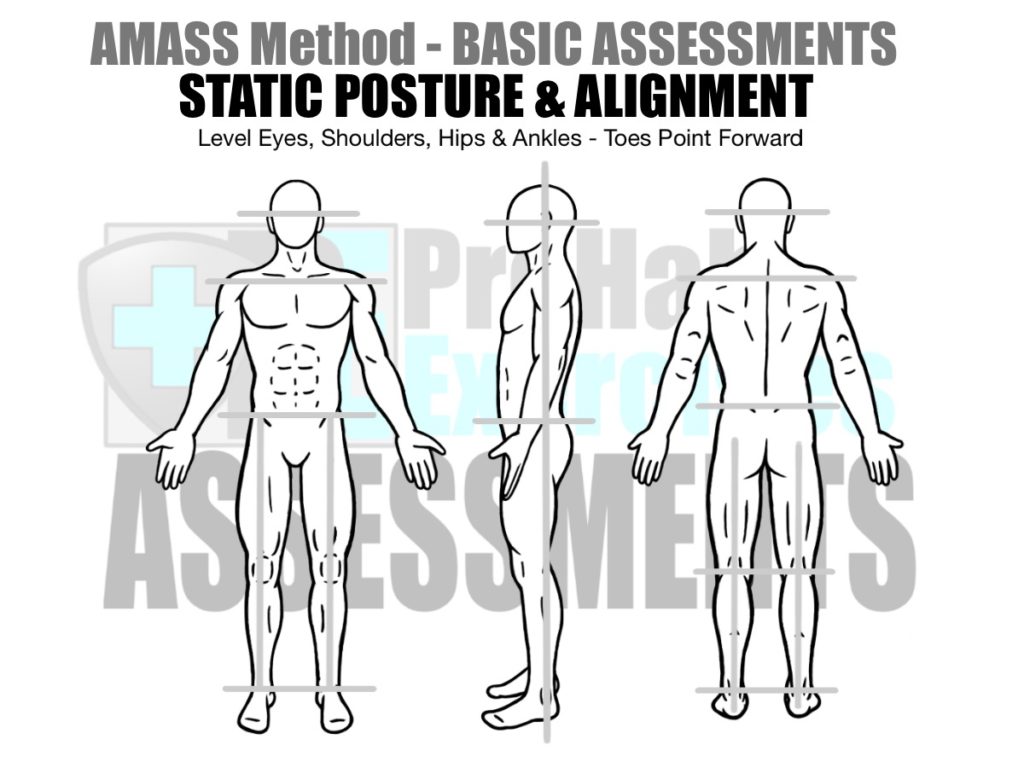
STATIC POSTURE
Assess if the Head, Shoulders, Spine, Hips, and Ankles are in Neutral Alignment.
ANTERIOR (FRONT)
• Are the Ears parallel with the floor?
• Are the Shoulders parallel with the floor?
• Are the Hips parallel with the floor?
• Do the Knees align with the Hip Socket and center of the Ankles?
• Do the Ankles collapse in towards the Midline of the body?
• Are the Ears parallel with the floor?
• Are the Shoulders parallel with the floor?
• Are the Hips parallel with the floor?
• Do the Knees align with the Hip Socket and center of the Ankles?
• Do the Ankles collapse in towards the Midline of the body?
LATERAL (PROFILE)
• Is the Head level?
• Are the Hips level with the floor?
• Do the Ears align over the Shoulders, Hips, and Ankles?
• Look for Forward Head Posture, Rounded Shoulders, excessive curvature of the Spine, and a tilted Pelvis (Hips).
• Is the Head level?
• Are the Hips level with the floor?
• Do the Ears align over the Shoulders, Hips, and Ankles?
• Look for Forward Head Posture, Rounded Shoulders, excessive curvature of the Spine, and a tilted Pelvis (Hips).
POSTERIOR (BACK)
• Are the Ears parallel with the floor?
• Are the Shoulders parallel with the floor?
• Are the Hips parallel with the floor?
• Do the Knees align with the Hip Socket and center of the Ankles?
• Do the Ankles collapse in towards the Midline of the body?
• Are the Ears parallel with the floor?
• Are the Shoulders parallel with the floor?
• Are the Hips parallel with the floor?
• Do the Knees align with the Hip Socket and center of the Ankles?
• Do the Ankles collapse in towards the Midline of the body?
Incorporate PreHab Exercises, starting with Mobility training, for each region (Neck, Shoulders, Hips, Ankles) that fails to exhibit Neutral Alignment.
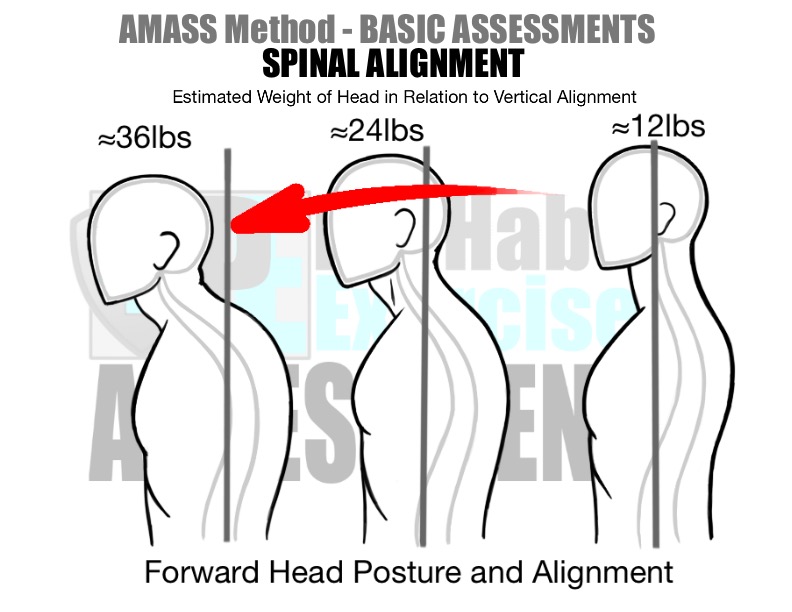
SPINAL ALIGNMENT – HEAD & NECK
Assess if the Head and Neck (Spine) are in Neutral Alignment.
HEAD & NECK ALIGNMENT
• Does the Ear vertically align over the Spine and Hips?
• Does the Thoracic Spine or Lumbar Spine exhibit excessive curvatures?
• Does the Head protract forward beyond the vertical alignment of the Spine and Hips?
• Does the Ear vertically align over the Spine and Hips?
• Does the Thoracic Spine or Lumbar Spine exhibit excessive curvatures?
• Does the Head protract forward beyond the vertical alignment of the Spine and Hips?
PREHAB EXERCISES
• Soft Tissue Therapy (Mobility) for the Neck and Shoulder muscles, especially the Upper Trapezius and Chest Muscles.
• Stretch (Mobility) the Head, Neck, and Shoulders.
• Activate Core and Shoulder Muscles, especially the Deep Neck Flexors, Shoulder Girdle, Abdominals, and Oblique muscles.
• Practice Stability exercises for the Shoulders and Core.
• Soft Tissue Therapy (Mobility) for the Neck and Shoulder muscles, especially the Upper Trapezius and Chest Muscles.
• Stretch (Mobility) the Head, Neck, and Shoulders.
• Activate Core and Shoulder Muscles, especially the Deep Neck Flexors, Shoulder Girdle, Abdominals, and Oblique muscles.
• Practice Stability exercises for the Shoulders and Core.
Start with Mobility exercises and progress to Activation and Stability exercises for these regions if the Head and Neck (Spine) fail to exhibit Neutral Alignment.
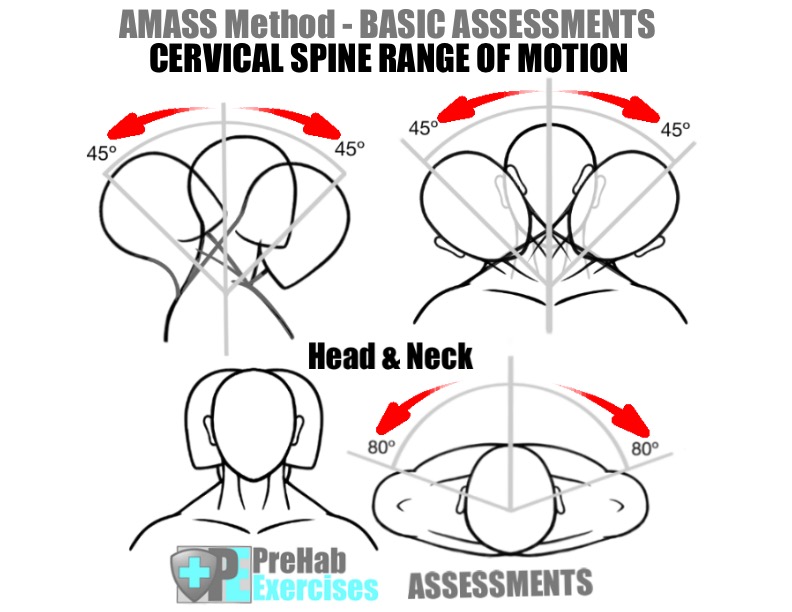
CERVICAL SPINE RANGE OF MOTION
HEAD & NECK
Assess the Range of Motion of the Cervical Spine – Head and Neck.
HEAD & NECK RANGE OF MOTION
• FLEXION & EXTENSION: Can the Head ‘nod yes’ with a Range of Motion of 45º in each direction?
• LATERAL FLEXION: Can the Head tilt from Left to Right with a Range of Motion of 45º in each direction?
• ROTATION: Can the Head ‘nod no’ or turn from Left to Right with a Range of Motion of 80º in each direction?
• FLEXION & EXTENSION: Can the Head ‘nod yes’ with a Range of Motion of 45º in each direction?
• LATERAL FLEXION: Can the Head tilt from Left to Right with a Range of Motion of 45º in each direction?
• ROTATION: Can the Head ‘nod no’ or turn from Left to Right with a Range of Motion of 80º in each direction?
PREHAB EXERCISES
• Soft Tissue Therapy (Mobility) for Neck and Shoulder muscles, especially the Upper Trapezius and Chest Muscles.
• Stretch (Mobility) the Head, Neck, and Shoulders.
• Activate Core and Shoulder Muscles, especially the Deep Neck Flexors, Shoulder Girdle, Abdominals, and Oblique muscles.
• Soft Tissue Therapy (Mobility) for Neck and Shoulder muscles, especially the Upper Trapezius and Chest Muscles.
• Stretch (Mobility) the Head, Neck, and Shoulders.
• Activate Core and Shoulder Muscles, especially the Deep Neck Flexors, Shoulder Girdle, Abdominals, and Oblique muscles.
Start with Mobility exercises and progress to Activation and Stability exercises if the Head and Neck (Spine) fail to exhibit a full Range of Motion.
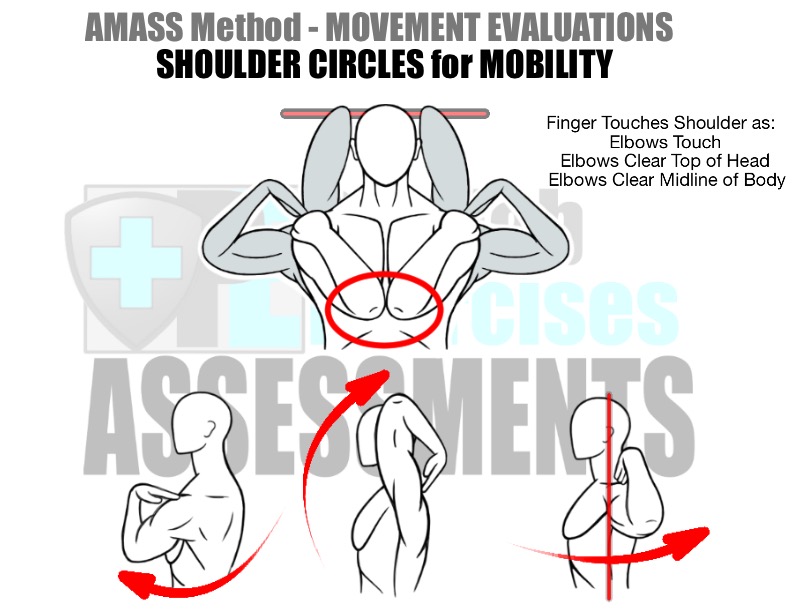
SHOULDER RANGE OF MOTION – Shoulder Circles
Assess the Range of Motion of the Shoulders.
SHOULDERS RANGE OF MOTION
• ADDUCTION: Can the Elbows touch each other in front of the Heart with the middle finger touching the Shoulder?
• FLEXION: Can the Elbows extend over the top of the Head with the middle finger touching the Shoulder?
• ABDUCTION: Can the Elbows reach backwards behind the Spine and Ears (Midline of the Body) with the middle finger touching the Shoulder?
• ADDUCTION: Can the Elbows touch each other in front of the Heart with the middle finger touching the Shoulder?
• FLEXION: Can the Elbows extend over the top of the Head with the middle finger touching the Shoulder?
• ABDUCTION: Can the Elbows reach backwards behind the Spine and Ears (Midline of the Body) with the middle finger touching the Shoulder?
PREHAB EXERCISES
• Soft Tissue Therapy (Mobility) for Neck, Shoulders, Chest, and Back muscles, especially the Upper Trapezius (Shoulder), Pectorals (Chest), and Latissimus Dorsi (Back) Muscles.
• Stretch (Mobility) the Neck, Shoulders, Chest and Back muscles.
• Activate Core and Shoulder Muscles, especially the Shoulder Girdle and Rotator Cuff muscles.
• Soft Tissue Therapy (Mobility) for Neck, Shoulders, Chest, and Back muscles, especially the Upper Trapezius (Shoulder), Pectorals (Chest), and Latissimus Dorsi (Back) Muscles.
• Stretch (Mobility) the Neck, Shoulders, Chest and Back muscles.
• Activate Core and Shoulder Muscles, especially the Shoulder Girdle and Rotator Cuff muscles.
Start with Mobility exercises and progress to Activation and Stability exercises if the Shoulders fail to exhibit a full Range of Motion.
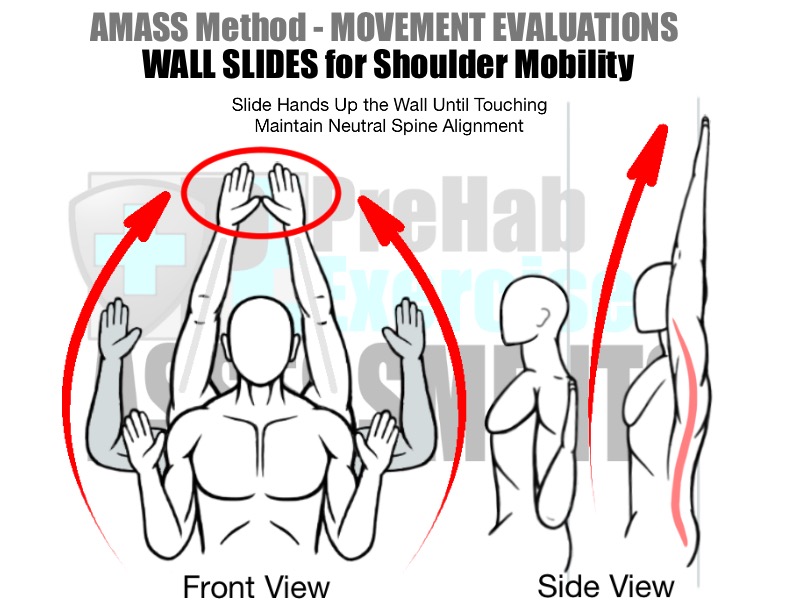
SHOULDER RANGE OF MOTION – Wall Slides
Assess the Range of Motion of the Shoulders.
SHOULDERS RANGE OF MOTION
• Position the Head, Torso, and Hip against the wall in Neutral Alignment.
• Hold the Hands out to the side with the Forearms in a vertical position and the backs of the Hands and Elbows pressing into the Wall if possible.
• Slide the Arms up overhead until the Elbows fully extend (straighten) and the Thumbs touch as the backs of the Hands press into the Wall.
• Maintain Neutral Alignment in the Spine throughout the movement.
• Position the Head, Torso, and Hip against the wall in Neutral Alignment.
• Hold the Hands out to the side with the Forearms in a vertical position and the backs of the Hands and Elbows pressing into the Wall if possible.
• Slide the Arms up overhead until the Elbows fully extend (straighten) and the Thumbs touch as the backs of the Hands press into the Wall.
• Maintain Neutral Alignment in the Spine throughout the movement.
PREHAB EXERCISES
• Soft Tissue Therapy (Mobility) for Neck, Shoulder, Chest, and Back muscles, especially the Upper Trapezius (Shoulder), Pectorals (Chest), and Latissimus Dorsi (Back) Muscles.
• Stretch (Mobility) the Neck, Shoulder, Chest, and Back muscles.
• Activate Core and Shoulder Muscles, especially the Shoulder Girdle, Rotator Cuff, and Anterior Core (Abdominals and Oblique) muscles.
• Soft Tissue Therapy (Mobility) for Neck, Shoulder, Chest, and Back muscles, especially the Upper Trapezius (Shoulder), Pectorals (Chest), and Latissimus Dorsi (Back) Muscles.
• Stretch (Mobility) the Neck, Shoulder, Chest, and Back muscles.
• Activate Core and Shoulder Muscles, especially the Shoulder Girdle, Rotator Cuff, and Anterior Core (Abdominals and Oblique) muscles.
Start with Mobility exercises and progress to Activation and Stability exercises if the Shoulders fail to exhibit a full Range of Motion.
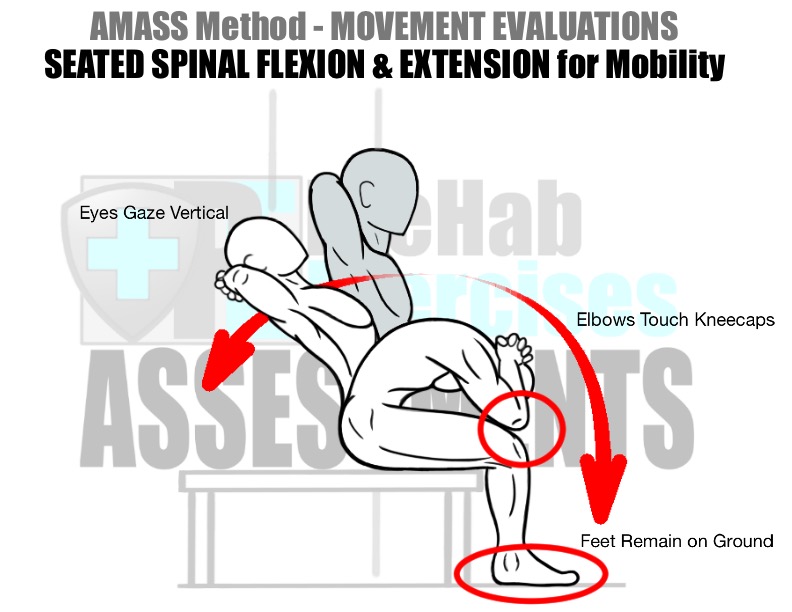
SPINAL RANGE OF MOTION – FLEXION & EXTENSION
Assess the Range of Motion of the Spine.
SPINAL RANGE OF MOTION
• POSITION: Sit on a bench with Feet firmly on the floor and Hands interlaced behind the Head.
• SPINAL FLEXION: Fold forward and attempt to touch the Elbows to the Kneecaps, not the Thighs, while Feet remain firmly on the floor.
• SPINAL EXTENSION: Lean backwards with the Shoulders and Head and attempt to gaze up at the sky (180º) while the Feet remain firmly on the floor.
• POSITION: Sit on a bench with Feet firmly on the floor and Hands interlaced behind the Head.
• SPINAL FLEXION: Fold forward and attempt to touch the Elbows to the Kneecaps, not the Thighs, while Feet remain firmly on the floor.
• SPINAL EXTENSION: Lean backwards with the Shoulders and Head and attempt to gaze up at the sky (180º) while the Feet remain firmly on the floor.
PREHAB EXERCISES
• Soft Tissue Therapy (Mobility) for Chest and Back muscles, especially the Upper Trapezius (Shoulder), Pectorals (Chest), and Latissimus Dorsi (Back) Muscles.
• Stretch (Mobility) the Neck, Shoulder, Chest, and Back muscles.
• Activate Core and Shoulder Muscles, especially the Shoulder Girdle, Rotator Cuff, and Anterior Core (Abdominals and Oblique) muscles.
• Soft Tissue Therapy (Mobility) for Chest and Back muscles, especially the Upper Trapezius (Shoulder), Pectorals (Chest), and Latissimus Dorsi (Back) Muscles.
• Stretch (Mobility) the Neck, Shoulder, Chest, and Back muscles.
• Activate Core and Shoulder Muscles, especially the Shoulder Girdle, Rotator Cuff, and Anterior Core (Abdominals and Oblique) muscles.
Start with Mobility exercises and progress to Activation and Stability exercises if the Spine fails to exhibit a full Range of Motion.
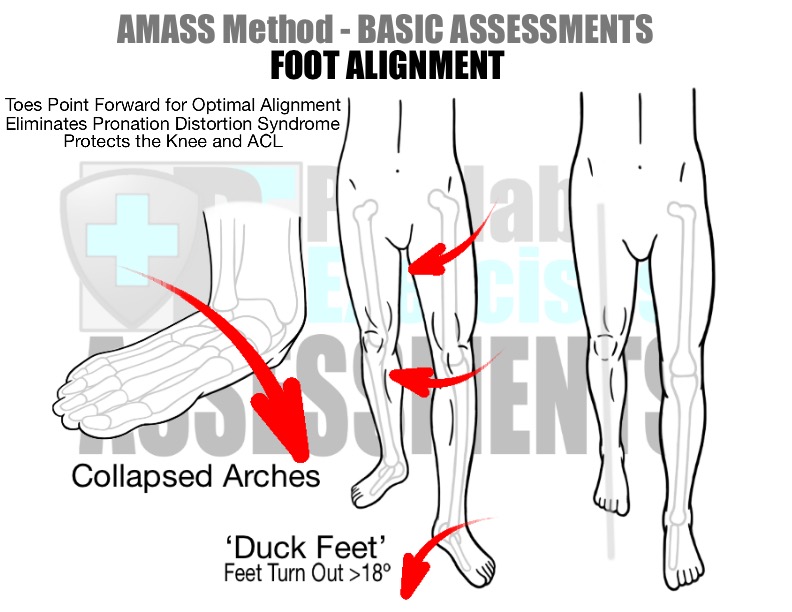
FOOT ALIGNMENT
Assess if the Foot and Ankle are in Neutral Alignment.
FOOT ALIGNMENT
• Do the Toes point forward?
• Does the Foot ‘turn out’ or point out to the sides by an angle greater than 18º of Abduction (away from center)?
• Does the Arch of the Foot ‘collapse’ or drop towards the floor?
• Do the Toes point forward?
• Does the Foot ‘turn out’ or point out to the sides by an angle greater than 18º of Abduction (away from center)?
• Does the Arch of the Foot ‘collapse’ or drop towards the floor?
PREHAB EXERCISES
• Soft Tissue Therapy (Mobility) for the Intrinsic Foot Muscles, Plantar Fascia, Calf Muscles, and Adductors (Groin) Muscles.
• Stretch (Mobility) the Foot, Calf, and Ankles.
• Activate the Foot, Ankle, and Hip Muscles, especially the Calf and Lateral Hip muscles.
• Practice Stability exercises for the Ankle, Hip, and Posterior Chain.
• Soft Tissue Therapy (Mobility) for the Intrinsic Foot Muscles, Plantar Fascia, Calf Muscles, and Adductors (Groin) Muscles.
• Stretch (Mobility) the Foot, Calf, and Ankles.
• Activate the Foot, Ankle, and Hip Muscles, especially the Calf and Lateral Hip muscles.
• Practice Stability exercises for the Ankle, Hip, and Posterior Chain.
Start with Mobility exercises and progress to Activation and Stability exercises for this region if the Foot and Ankle fail to exhibit Neutral Alignment.
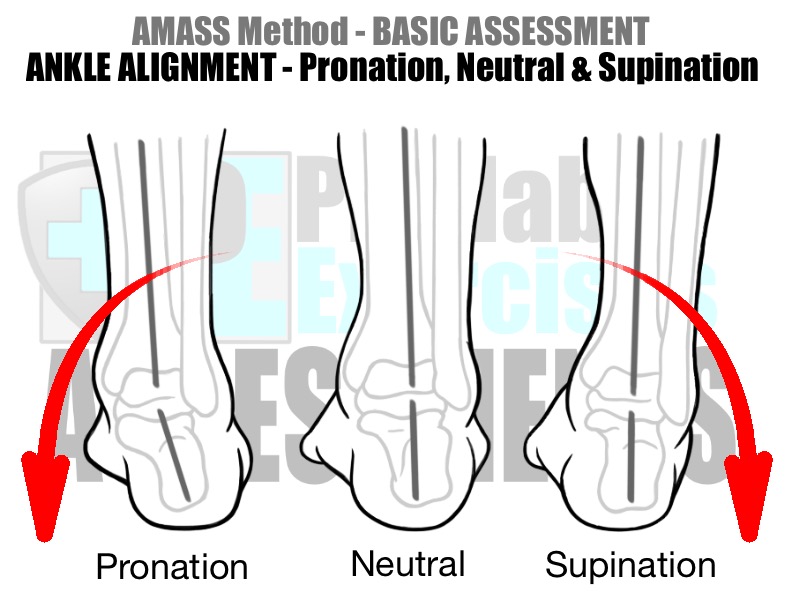
ANKLE ALIGNMENT – PRONATION, NEUTRAL & SUPINATION
Assess the Alignment of the Ankle.
ALIGNMENT CUES
• Viewing the Ankle from the front or back, observe the Anklebones and draw an imaginary line down the Achilles Tendon to the Heel.
• If the Ankle rolls or ‘collapses’ in towards the Midline of the body, the Ankle is in Pronation. If the Ankle rolls out away from the Midline of the body, the Ankle is in Supination.
• Note: Any malalignments (Pronation or Supination) in the Ankle create compensation patterns in an individual’s running technique.
• Viewing the Ankle from the front or back, observe the Anklebones and draw an imaginary line down the Achilles Tendon to the Heel.
• If the Ankle rolls or ‘collapses’ in towards the Midline of the body, the Ankle is in Pronation. If the Ankle rolls out away from the Midline of the body, the Ankle is in Supination.
• Note: Any malalignments (Pronation or Supination) in the Ankle create compensation patterns in an individual’s running technique.
PREHAB EXERCISES
• Soft Tissue Therapy (Mobility) for the Foot, Ankle, Leg, and Hip Muscles.
• Stretch (Mobility) the Foot, Ankle, Leg, Hip, and Posterior Chain with isolated and Combination Mobility Exercises.
• Activate the Foot, Ankle, Hip, and Posterior Chain Muscles with isolated and Combination Activation Exercises.
• Stabilize the Ankle and Hips with isolated and Combination Exercises.
• Soft Tissue Therapy (Mobility) for the Foot, Ankle, Leg, and Hip Muscles.
• Stretch (Mobility) the Foot, Ankle, Leg, Hip, and Posterior Chain with isolated and Combination Mobility Exercises.
• Activate the Foot, Ankle, Hip, and Posterior Chain Muscles with isolated and Combination Activation Exercises.
• Stabilize the Ankle and Hips with isolated and Combination Exercises.
Start with Mobility exercises and progress to Activation and Stability exercises if the individual fails to exhibit an adequate amount of Stability.
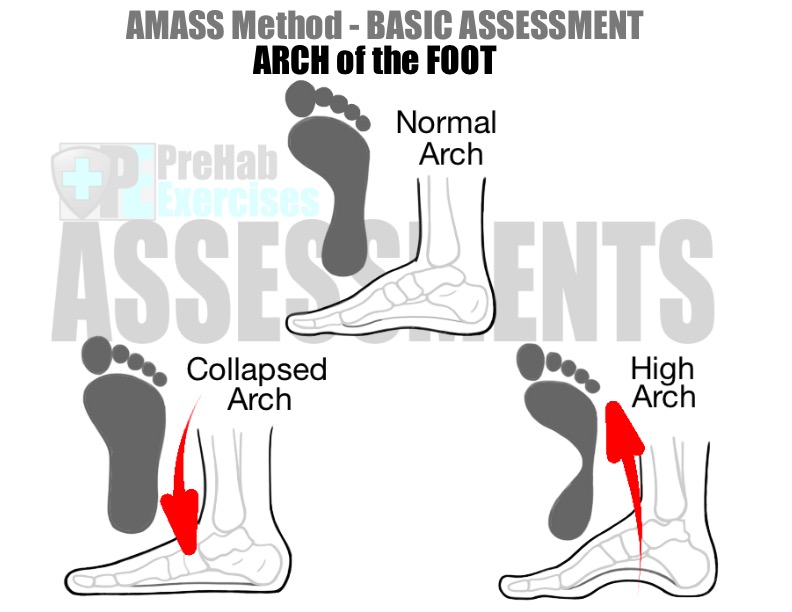
ARCH OF THE FOOT
Assess the Arch of the Foot.
ALIGNMENT CUES
• Viewing the Foot from the inside and observing the type of Footprint, assess the Arch of the Foot.
• A ‘Collapsed’ Arch creates a wide Footprint and a ‘High’ Arch creates a thin Footprint. A ‘Normal’ Arch creates a slender Footprint.
• Note: Any malalignments (High or Collapsed Arches) in the Foot create compensation patterns in an individual’s running technique.
• Viewing the Foot from the inside and observing the type of Footprint, assess the Arch of the Foot.
• A ‘Collapsed’ Arch creates a wide Footprint and a ‘High’ Arch creates a thin Footprint. A ‘Normal’ Arch creates a slender Footprint.
• Note: Any malalignments (High or Collapsed Arches) in the Foot create compensation patterns in an individual’s running technique.
PREHAB EXERCISES
• Soft Tissue Therapy (Mobility) for the Foot, Ankle, Leg, and Hip Muscles.
• Stretch (Mobility) the Foot, Ankle, Leg, Hip, and Posterior Chain with isolated and Combination Mobility Exercises.
• Activate the Foot, Ankle, Hip, and Posterior Chain Muscles with isolated and Combination Activation Exercises.
• Stabilize the Ankle and Hips with isolated and Combination Exercises.
• Soft Tissue Therapy (Mobility) for the Foot, Ankle, Leg, and Hip Muscles.
• Stretch (Mobility) the Foot, Ankle, Leg, Hip, and Posterior Chain with isolated and Combination Mobility Exercises.
• Activate the Foot, Ankle, Hip, and Posterior Chain Muscles with isolated and Combination Activation Exercises.
• Stabilize the Ankle and Hips with isolated and Combination Exercises.
Start with Mobility exercises and progress to Activation and Stability exercises if the individual fails to exhibit an adequate amount of Stability.
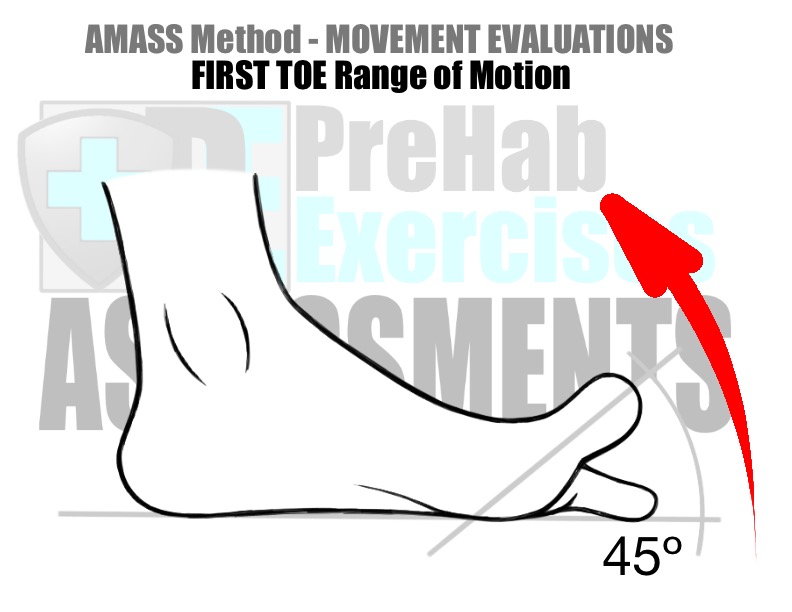
FIRST TOE RANGE OF MOTION
Assess the Range of Motion of the First Toe.
ALIGNMENT CUES
• Place Foot on the floor and lift the First Toe (Big Toe) up towards the sky as high as possible.
• The optimal Range of Motion for the First Toe is 45º or more.
• Note: Any limitation in the First Toe’s ROM (Range of Motion) disrupts an individual’s Gait Pattern and creates compensation patterns in his/her running technique.
• Place Foot on the floor and lift the First Toe (Big Toe) up towards the sky as high as possible.
• The optimal Range of Motion for the First Toe is 45º or more.
• Note: Any limitation in the First Toe’s ROM (Range of Motion) disrupts an individual’s Gait Pattern and creates compensation patterns in his/her running technique.
PREHAB EXERCISES
• Soft Tissue Therapy (Mobility) for the Foot, Ankle, and Calf.
• Stretch (Mobility) the Foot, Ankle, and Posterior Chain with isolated and Combination Mobility Exercises.
• Activate the Foot, Ankle, Hip, and Posterior Chain Muscles with isolated and Combination Activation Exercises.
• Stabilize the Ankle and Hips with isolated and Combination Exercises.
• Soft Tissue Therapy (Mobility) for the Foot, Ankle, and Calf.
• Stretch (Mobility) the Foot, Ankle, and Posterior Chain with isolated and Combination Mobility Exercises.
• Activate the Foot, Ankle, Hip, and Posterior Chain Muscles with isolated and Combination Activation Exercises.
• Stabilize the Ankle and Hips with isolated and Combination Exercises.
Start with Mobility exercises and progress to Activation and Stability exercises if the individual fails to exhibit an adequate amount of Stability.
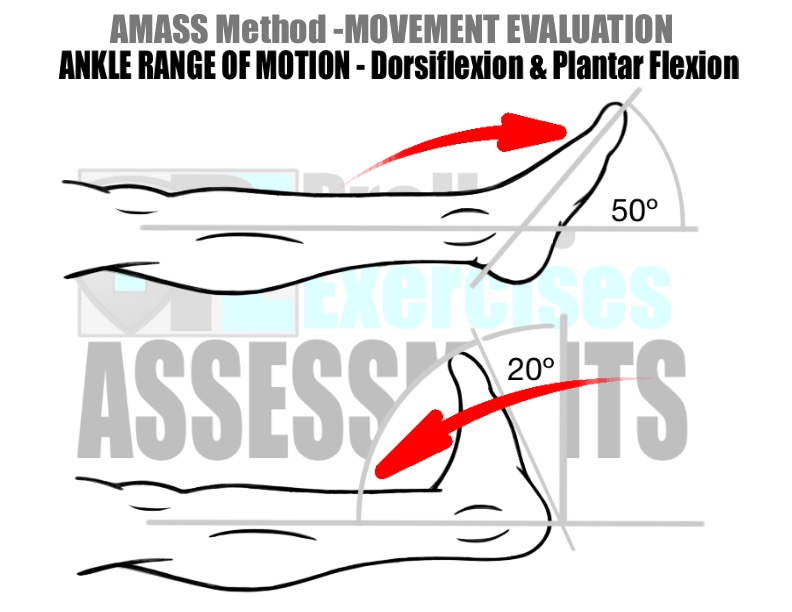
ANKLE RANGE OF MOTION – DORSIFLEXION & PLANTAR FLEXION
Assess the Range of Motion of the Ankle.
ALIGNMENT CUES
• Point the Toes away from the Shin (Plantar Flexion) and then pull the Toes back towards the Shin (Dorsiflexion).
• The optimal Range of Motion for Plantar Flexion (Toes Point Away from Shin) is 50º or more.
• The optimal Range of Motion for Dorsiflexion (Toes Point Towards Shin) is 20º or more.
• Note: Any limitation in the Ankle’s Range of Motion creates compensation patterns in an individual’s running technique.
• Point the Toes away from the Shin (Plantar Flexion) and then pull the Toes back towards the Shin (Dorsiflexion).
• The optimal Range of Motion for Plantar Flexion (Toes Point Away from Shin) is 50º or more.
• The optimal Range of Motion for Dorsiflexion (Toes Point Towards Shin) is 20º or more.
• Note: Any limitation in the Ankle’s Range of Motion creates compensation patterns in an individual’s running technique.
PREHAB EXERCISES
• Soft Tissue Therapy (Mobility) for the Foot, Ankle, and Calf.
• Stretch (Mobility) the Foot, Ankle, and Posterior Chain with isolated and Combination Mobility Exercises.
• Activate the Foot, Ankle, Hip, and Posterior Chain Muscles with isolated and Combination Activation Exercises.
• Stabilize the Ankle and Hips with isolated and Combination Exercises.
• Soft Tissue Therapy (Mobility) for the Foot, Ankle, and Calf.
• Stretch (Mobility) the Foot, Ankle, and Posterior Chain with isolated and Combination Mobility Exercises.
• Activate the Foot, Ankle, Hip, and Posterior Chain Muscles with isolated and Combination Activation Exercises.
• Stabilize the Ankle and Hips with isolated and Combination Exercises.
Start with Mobility exercises and progress to Activation and Stability exercises if the individual fails to exhibit an adequate amount of Stability.
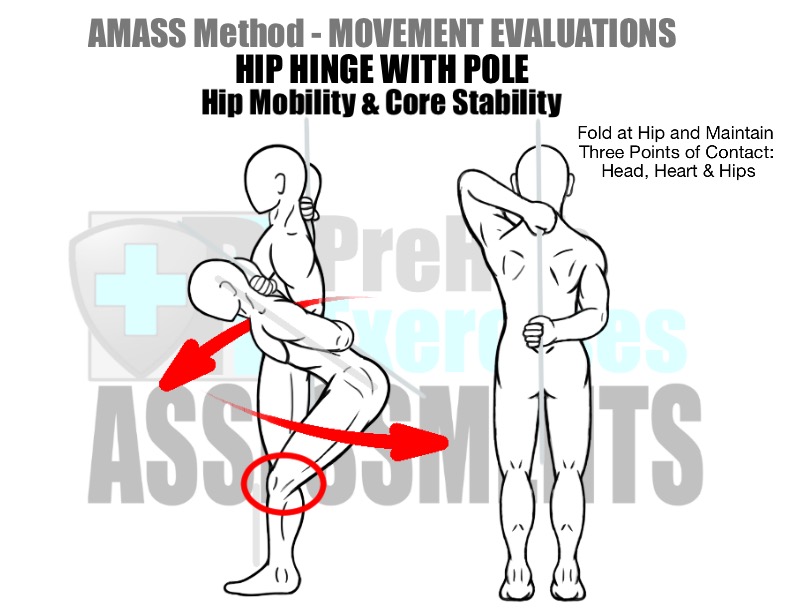
HIP HINGE WITH POLE – ASSESSING HIP MOBILITY & CORE STABILITY
Assess the Range of Motion of Hip Flexion and Core (Spinal) Stability.
HIP HINGE RANGE OF MOTION
• POSITION: Stand with Feet Hip-width apart and hold a pole along the Back (Spine) with Hands behind the Neck and Low Back as the Head, Heart, and Hips all touch the Pole.
• HINGE: Simultaneously bend the Knees and Hips while leaning forward with the Torso, keeping the Chest over the vertical Shins.
• ALIGNMENT: Attempt to flex the Hips to 90º while keeping the Head, Heart, and Hips touching the pole.
• POSITION: Stand with Feet Hip-width apart and hold a pole along the Back (Spine) with Hands behind the Neck and Low Back as the Head, Heart, and Hips all touch the Pole.
• HINGE: Simultaneously bend the Knees and Hips while leaning forward with the Torso, keeping the Chest over the vertical Shins.
• ALIGNMENT: Attempt to flex the Hips to 90º while keeping the Head, Heart, and Hips touching the pole.
PREHAB EXERCISES
• Soft Tissue Therapy (Mobility) for Hips, Legs, and Back muscles, especially the Glutes (Hips), Hamstrings (Legs), and Latissimus Dorsi (Back) Muscles.
• Stretch (Mobility) the Hips, Leg, and Back muscles.
• Activate Core Muscles, especially the Anterior Core (Abdominals and Oblique) muscles.
• Practice Core, Hip, and Combination Stability exercises.
• Soft Tissue Therapy (Mobility) for Hips, Legs, and Back muscles, especially the Glutes (Hips), Hamstrings (Legs), and Latissimus Dorsi (Back) Muscles.
• Stretch (Mobility) the Hips, Leg, and Back muscles.
• Activate Core Muscles, especially the Anterior Core (Abdominals and Oblique) muscles.
• Practice Core, Hip, and Combination Stability exercises.
Start with Mobility exercises and progress to Activation and Stability exercises if the individual fails to exhibit a full Range of Motion in the Hip Hinge.
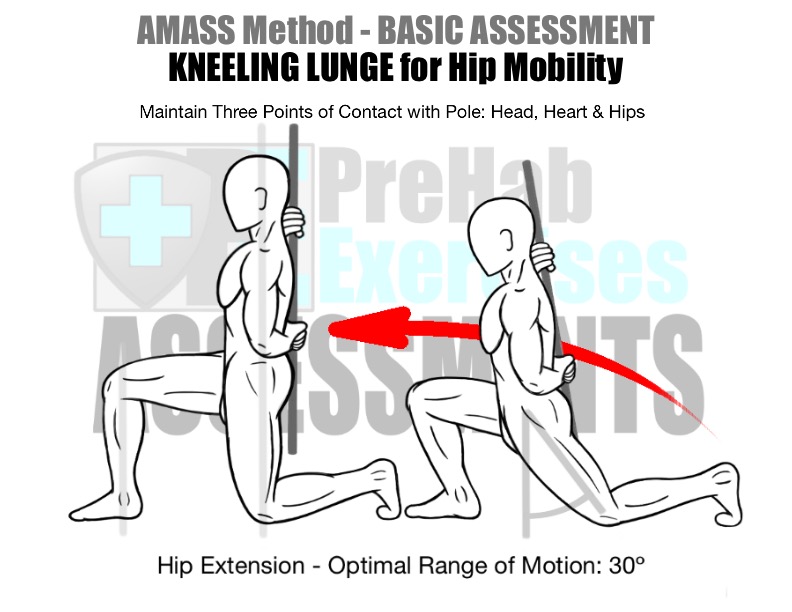
KNEELING LUNGE WITH POLE – ASSESSING HIP MOBILITY & CORE STABILITY
Assess the Range of Motion of Hip Extension and Core (Spinal) Stability.
LUNGE RANGE OF MOTION
• POSITION: Kneel on one Knee and hold a pole along the Back (Spine) with Hands behind the Neck and Low Back as the Head, Heart, and Hips all touch the Pole.
• LUNGE: Smoothly lunge forward with the Hips as far as possible while keeping the Head, Heart, and Hips touching the pole.
• HIP EXTENSION: Attempt to lunge forward with a Neutral Spine into a Hip Extension of 10º (Minimum) to 30º (Optimal).
• POSITION: Kneel on one Knee and hold a pole along the Back (Spine) with Hands behind the Neck and Low Back as the Head, Heart, and Hips all touch the Pole.
• LUNGE: Smoothly lunge forward with the Hips as far as possible while keeping the Head, Heart, and Hips touching the pole.
• HIP EXTENSION: Attempt to lunge forward with a Neutral Spine into a Hip Extension of 10º (Minimum) to 30º (Optimal).
PREHAB EXERCISES
• Soft Tissue Therapy (Mobility) for the Hips, Legs, and Back muscles, especially the Glutes (Hips), Hamstrings (Legs), and Latissimus Dorsi (Back) Muscles.
• Stretch (Mobility) the Hips, Leg, and Back muscles.
• Activate Core Muscles, especially the Anterior Core (Abdominals and Oblique) muscles.
• Practice Core, Hip, and Combination Stability exercises.
• Soft Tissue Therapy (Mobility) for the Hips, Legs, and Back muscles, especially the Glutes (Hips), Hamstrings (Legs), and Latissimus Dorsi (Back) Muscles.
• Stretch (Mobility) the Hips, Leg, and Back muscles.
• Activate Core Muscles, especially the Anterior Core (Abdominals and Oblique) muscles.
• Practice Core, Hip, and Combination Stability exercises.
Start with Mobility exercises and progress to Activation and Stability exercises if the Hips fail to exhibit a full Range of Motion.
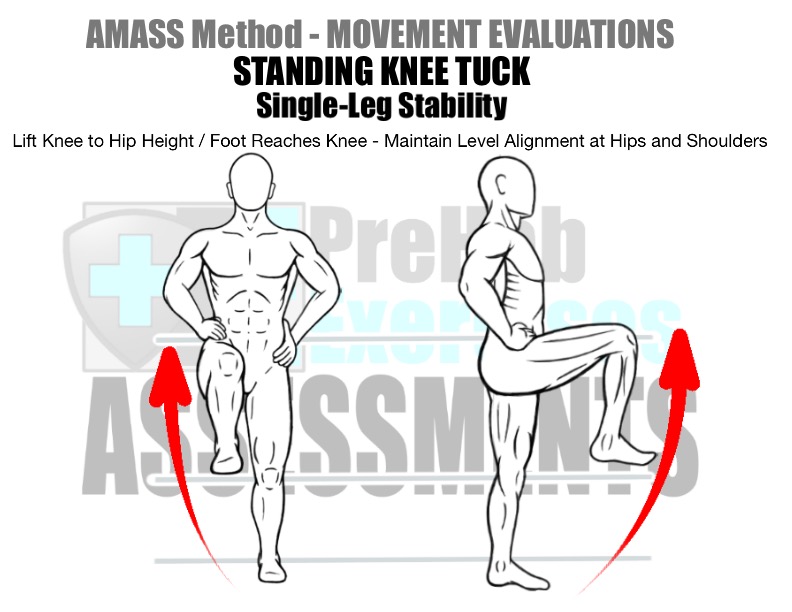
STANDING KNEE TUCK – ASSESSING HIP FLEXION & SINGLE-LEG STABILITY
Assess the Range of Motion of Hip Flexion and Single-Leg Stability.
STANDING KNEE TUCK
• POSITION: Stand tall with Feet together and Hands on Hips.
• KNEE TUCK: Lift one Knee up to match the height of the top of the Hips or higher. The Foot should clear the height of the Opposite Knee.
• SINGLE-LEG STABILITY: Attempt to keep the Hips level with the ground and maintain neutral alignment of the Standing Leg, i.e. Hip, Knee, and Ankle in vertical alignment without a collapsed Arch in the Foot.
• POSITION: Stand tall with Feet together and Hands on Hips.
• KNEE TUCK: Lift one Knee up to match the height of the top of the Hips or higher. The Foot should clear the height of the Opposite Knee.
• SINGLE-LEG STABILITY: Attempt to keep the Hips level with the ground and maintain neutral alignment of the Standing Leg, i.e. Hip, Knee, and Ankle in vertical alignment without a collapsed Arch in the Foot.
PREHAB EXERCISES
• Soft Tissue Therapy (Mobility) for the Hip, Leg, and Foot muscles, especially the Glutes (Hips) and the Hamstrings (Leg) Muscles.
• Stretch (Mobility) the Glutes (Hips) and Hamstring (Leg) muscles.
• Activate Hip, Leg, Foot, and Core Muscles, especially the Hip Flexors, Gluteus Medius (Lateral Hip), Intrinsic Foot, Calf, and Core (Abdominals and Oblique) muscles.
• Practice Core and Single-Leg Stability Exercises.
• Soft Tissue Therapy (Mobility) for the Hip, Leg, and Foot muscles, especially the Glutes (Hips) and the Hamstrings (Leg) Muscles.
• Stretch (Mobility) the Glutes (Hips) and Hamstring (Leg) muscles.
• Activate Hip, Leg, Foot, and Core Muscles, especially the Hip Flexors, Gluteus Medius (Lateral Hip), Intrinsic Foot, Calf, and Core (Abdominals and Oblique) muscles.
• Practice Core and Single-Leg Stability Exercises.
Start with Mobility exercises and progress to Activation and Stability exercises if the individual fails to exhibit a full Range of Motion or Stability.
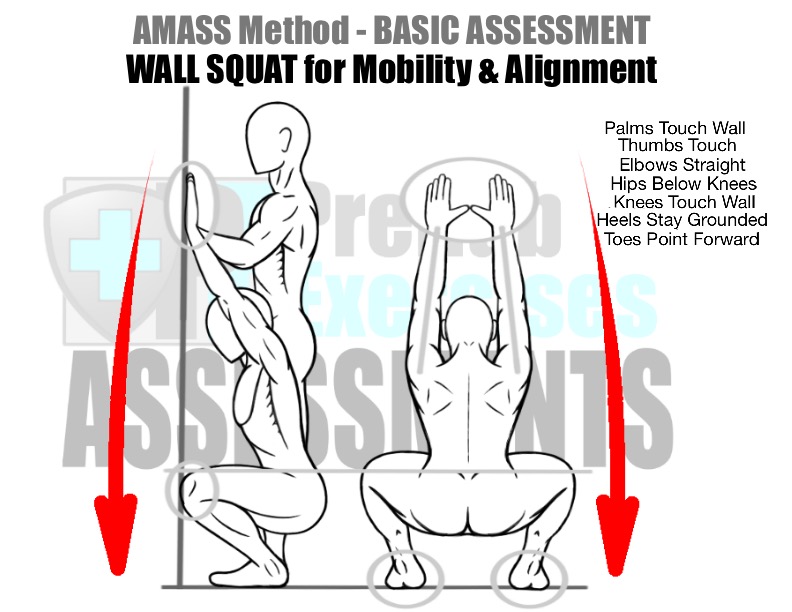
WALL SQUAT (ANTERIOR WALL SQUAT)
Assess the combined Mobility of the Ankle, Hip, Thoracic Spine, and Shoulders.
ALIGNMENT CUES
• Squat with Feet shoulder-width apart, Toes pointing forward, Heels flat on the floor. (Ankle Mobility)
• Place Hands on the wall, Thumbs touching and Elbows straight. (Shoulder and Thoracic Spine Mobility)
• Kneecaps touch the wall with Knees pressed out (Abduction). (Hip Mobility and Activation)
• Hips should be at or below the height of the Knees. (Ankle, Hip, & Posterior Chain Mobility)
• Squat with Feet shoulder-width apart, Toes pointing forward, Heels flat on the floor. (Ankle Mobility)
• Place Hands on the wall, Thumbs touching and Elbows straight. (Shoulder and Thoracic Spine Mobility)
• Kneecaps touch the wall with Knees pressed out (Abduction). (Hip Mobility and Activation)
• Hips should be at or below the height of the Knees. (Ankle, Hip, & Posterior Chain Mobility)
PREHAB EXERCISES
• Soft Tissue Therapy (Mobility) for the Foot, Ankle, Hip, Thoracic Spine, Shoulders, and Posterior Chain.
• Stretch (Mobility) the Ankles, Hips, Thoracic Spine, and Shoulders with isolated and Combination Mobility Exercises.
• Activate the Core, Hip, and Posterior Chain Muscles with isolated and Combination Activation Exercises.
• Stabilize the Ankle, Core, Hip, and Posterior Chain with isolated and Combination Exercises.
• Soft Tissue Therapy (Mobility) for the Foot, Ankle, Hip, Thoracic Spine, Shoulders, and Posterior Chain.
• Stretch (Mobility) the Ankles, Hips, Thoracic Spine, and Shoulders with isolated and Combination Mobility Exercises.
• Activate the Core, Hip, and Posterior Chain Muscles with isolated and Combination Activation Exercises.
• Stabilize the Ankle, Core, Hip, and Posterior Chain with isolated and Combination Exercises.
Start with Mobility exercises and progress to Activation and Stability exercises if the individual fails to exhibit a full Range of Motion in the Wall Squat.
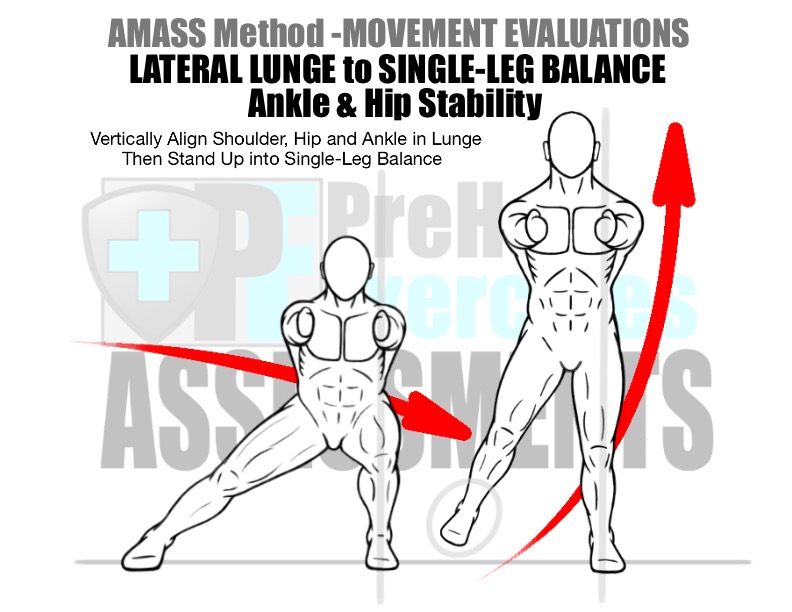
LATERAL LUNGE TO SINGLE-LEG BALANCE
Assess the combined Mobility and Stability of the Ankle, Hip and Posterior Chain.
ALIGNMENT CUES
• Stand with Feet 1½ Shoulder Width.
• Lunge to one side until the Shoulder and Hip vertically align over the Foot.
• Next, Lift the Trail Leg (Back Foot) off the ground.
• Stand up onto a Single-Leg and maintain vertical alignment of the Shoulder, Hip, and Foot.
• Stand with Feet 1½ Shoulder Width.
• Lunge to one side until the Shoulder and Hip vertically align over the Foot.
• Next, Lift the Trail Leg (Back Foot) off the ground.
• Stand up onto a Single-Leg and maintain vertical alignment of the Shoulder, Hip, and Foot.
PREHAB EXERCISES
• Soft Tissue Therapy (Mobility) for the Feet, Ankles, Legs, Hips, and Posterior Chain.
• Stretch (Mobility) the Ankles, Hips, and Posterior Chain with isolated and Combination Mobility Exercises.
• Activate Ankle, Hip, and Posterior Chain Muscles with isolated and Combination Activation Exercises.
• Stabilize the Ankle, Hip, and Posterior Chain with isolated and Combination Exercises.
• Soft Tissue Therapy (Mobility) for the Feet, Ankles, Legs, Hips, and Posterior Chain.
• Stretch (Mobility) the Ankles, Hips, and Posterior Chain with isolated and Combination Mobility Exercises.
• Activate Ankle, Hip, and Posterior Chain Muscles with isolated and Combination Activation Exercises.
• Stabilize the Ankle, Hip, and Posterior Chain with isolated and Combination Exercises.
Start with Mobility exercises and progress to Activation and Stability exercises if the individual fails to exhibit a full Range of Motion in the Lateral Lunge.
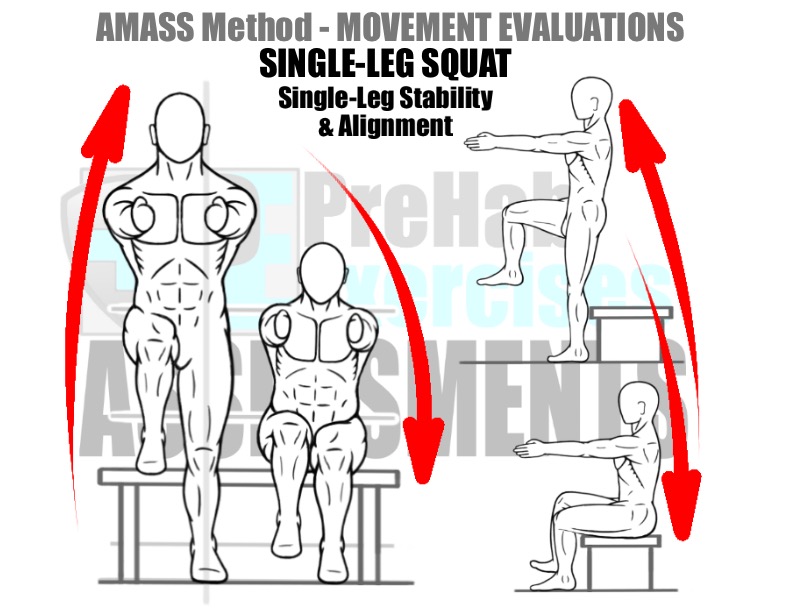
SINGLE-LEG SQUAT (SINGLE-LEG BOX SQUAT)
Assess the combined Stability of the Ankle, Hip, and Posterior Chain.
ALIGNMENT CUES
• Stand on one Foot (Single-Leg) with Arms extended for counterbalance and Knee tucked to Hip height.
• Next, sit down on a Knee height box/bench in a controlled manner. Do not flop or drop down.
• Then, with control, stand back up onto one Foot (Single-Leg) while maintaining vertical alignment of the Shoulder, Hip, and Foot.
• Watch for any involuntary or shaky movements, especially at the Knee.
• Stand on one Foot (Single-Leg) with Arms extended for counterbalance and Knee tucked to Hip height.
• Next, sit down on a Knee height box/bench in a controlled manner. Do not flop or drop down.
• Then, with control, stand back up onto one Foot (Single-Leg) while maintaining vertical alignment of the Shoulder, Hip, and Foot.
• Watch for any involuntary or shaky movements, especially at the Knee.
PREHAB EXERCISES
• Soft Tissue Therapy (Mobility) for the Feet, Ankles, Legs, Hips, and Posterior Chain.
• Stretch (Mobility) the Ankles, Hips, and Posterior Chain with isolated and Combination Mobility Exercises.
• Activate Ankle, Hip, and Posterior Chain Muscles with isolated and Combination Activation Exercises.
• Stabilize the Ankle, Hip, Posterior Chain, and Single-Leg positions with isolated and Combination Exercises.
• Soft Tissue Therapy (Mobility) for the Feet, Ankles, Legs, Hips, and Posterior Chain.
• Stretch (Mobility) the Ankles, Hips, and Posterior Chain with isolated and Combination Mobility Exercises.
• Activate Ankle, Hip, and Posterior Chain Muscles with isolated and Combination Activation Exercises.
• Stabilize the Ankle, Hip, Posterior Chain, and Single-Leg positions with isolated and Combination Exercises.
Start with Mobility exercises and progress to Activation and Stability exercises if the individual fails to exhibit a full Range of Motion in the Lateral Lunge.
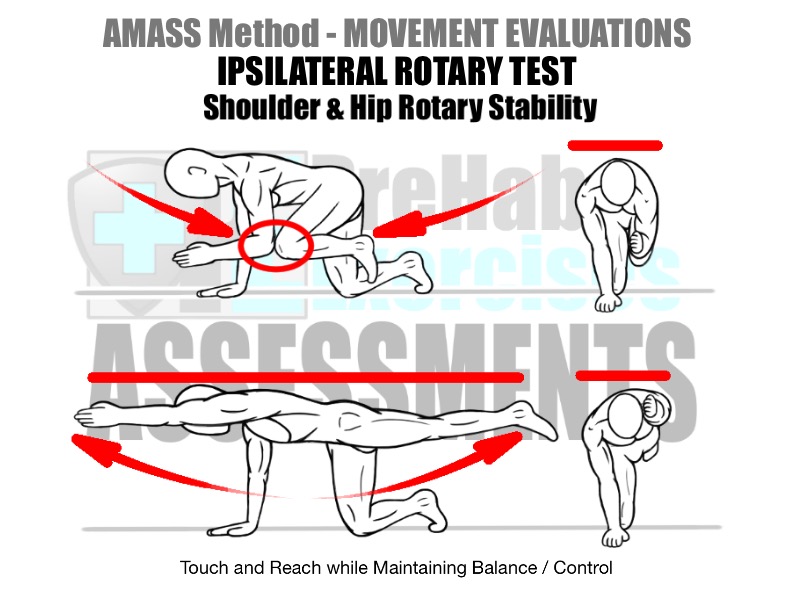
IPSILATERAL ROTARY STABILITY
IPSILATERAL ARM & LEG REACH
Assess the combined Stability of the Shoulders, Core, and Hips.
ALIGNMENT CUES
• Start in Quadruped, i.e. on ‘All Fours’ or on ‘Hands and Knees’.
• Reach same-side (ipsilateral) Hand and Foot towards the horizon.
• Touch same-side (ipsilateral) Elbow and Knee under the Torso.
• Re-extend same-side Hand and Foot towards the horizon before returning to Quadruped or All Fours.
• Maintain balance throughout the entire movement.
• Start in Quadruped, i.e. on ‘All Fours’ or on ‘Hands and Knees’.
• Reach same-side (ipsilateral) Hand and Foot towards the horizon.
• Touch same-side (ipsilateral) Elbow and Knee under the Torso.
• Re-extend same-side Hand and Foot towards the horizon before returning to Quadruped or All Fours.
• Maintain balance throughout the entire movement.
PREHAB EXERCISES
• Soft Tissue Therapy (Mobility) for the Hips, Shoulders, and Posterior Chain.
• Stretch (Mobility) the Hips, Shoulders and Posterior Chain with isolated and Combination Mobility Exercises.
• Activate the Hips, Core, and Shoulder Muscles with isolated and Combination Activation Exercises.
• Stabilize the Hips, Core, and Shoulders with isolated and Combination Exercises.
• Soft Tissue Therapy (Mobility) for the Hips, Shoulders, and Posterior Chain.
• Stretch (Mobility) the Hips, Shoulders and Posterior Chain with isolated and Combination Mobility Exercises.
• Activate the Hips, Core, and Shoulder Muscles with isolated and Combination Activation Exercises.
• Stabilize the Hips, Core, and Shoulders with isolated and Combination Exercises.
Start with Mobility exercises and progress to Activation and Stability exercises if the individual fails to exhibit a full Range of Motion and Stability.
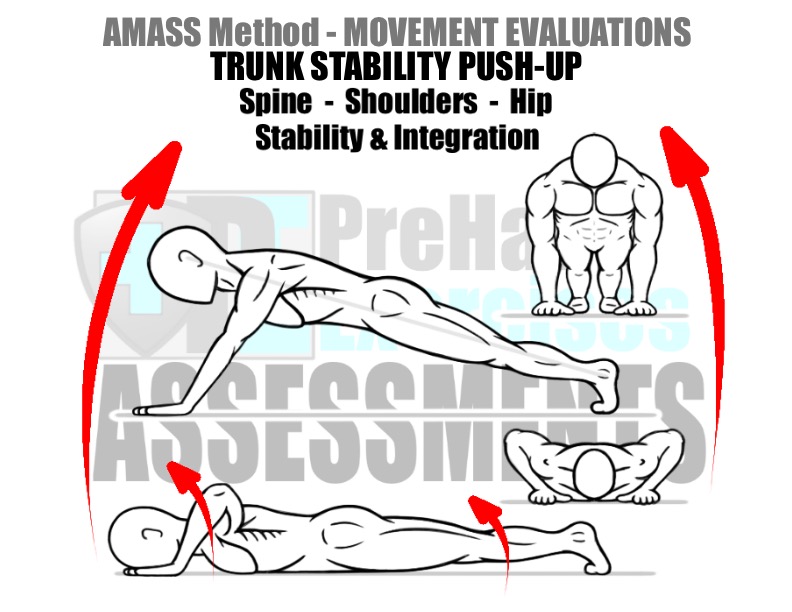
TRUNK STABILITY PUSH-UP
Assess the combined Stability and Integration of the Shoulders, Core, and Hips.
ALIGNMENT CUES
• Lie on the floor with Hands placed Shoulder-Width apart, aligned with the Forehead (advanced) or Chin (intermediate).
• Lift the Elbow and Knee off the floor.
• Push-up into a Plank Position in one smooth motion while maintaining a straight-line alignment from Ear to Hip to Knees to Ankle.
• Lie on the floor with Hands placed Shoulder-Width apart, aligned with the Forehead (advanced) or Chin (intermediate).
• Lift the Elbow and Knee off the floor.
• Push-up into a Plank Position in one smooth motion while maintaining a straight-line alignment from Ear to Hip to Knees to Ankle.
PREHAB EXERCISES
• Soft Tissue Therapy (Mobility) for the Shoulders and Chest.
• Stretch (Mobility) the Shoulders and Thoracic Spine with isolated and Combination Mobility Exercises.
• Activate the Core, Shoulders, and Hip Flexor Muscles with isolated and Combination Activation Exercises.
• Stabilize the Core, Shoulders, and Hips with isolated and Combination Exercises.
• Soft Tissue Therapy (Mobility) for the Shoulders and Chest.
• Stretch (Mobility) the Shoulders and Thoracic Spine with isolated and Combination Mobility Exercises.
• Activate the Core, Shoulders, and Hip Flexor Muscles with isolated and Combination Activation Exercises.
• Stabilize the Core, Shoulders, and Hips with isolated and Combination Exercises.
Start with Mobility exercises and progress to Activation and Stability exercises if the individual fails to exhibit an adequate amount of Stability.
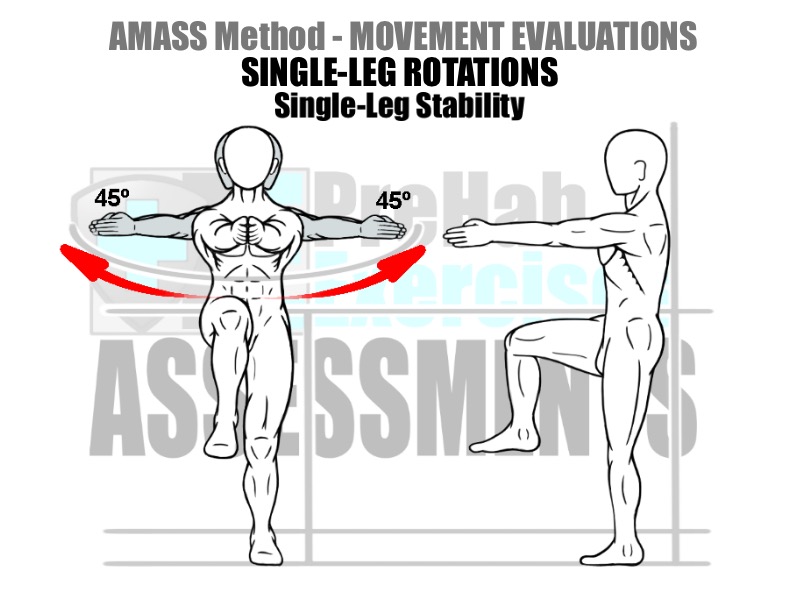
SINGLE-LEG ROTATION
Assess the combined Stability of the Ankle, Foot, and Hips.
ALIGNMENT CUES
• Stand on one leg (Single-Leg) with the opposite Knee tucked to Hip Height and both Arms extended to the horizon, parallel to the floor.
• Rotate the Shoulders to point the Arms to each side at a 45º angle before returning to the start position.
• Attempt to maintain balance in a relaxed manner with the Eyes watching the Hands throughout the entire movement.
• Stand on one leg (Single-Leg) with the opposite Knee tucked to Hip Height and both Arms extended to the horizon, parallel to the floor.
• Rotate the Shoulders to point the Arms to each side at a 45º angle before returning to the start position.
• Attempt to maintain balance in a relaxed manner with the Eyes watching the Hands throughout the entire movement.
PREHAB EXERCISES
• Soft Tissue Therapy (Mobility) for the Foot, Leg, and Hip.
• Stretch (Mobility) the Foot, Ankle, Hip, and Posterior Chain with isolated and Combination Mobility Exercises.
• Activate the Foot, Ankle, Hip, and Posterior Chain Muscles with isolated and Combination Activation Exercises.
• Stabilize the Ankle and Hips with isolated and Combination Exercises.
• Soft Tissue Therapy (Mobility) for the Foot, Leg, and Hip.
• Stretch (Mobility) the Foot, Ankle, Hip, and Posterior Chain with isolated and Combination Mobility Exercises.
• Activate the Foot, Ankle, Hip, and Posterior Chain Muscles with isolated and Combination Activation Exercises.
• Stabilize the Ankle and Hips with isolated and Combination Exercises.
Start with Mobility exercises and progress to Activation and Stability exercises if the individual fails to exhibit an adequate amount of Stability.
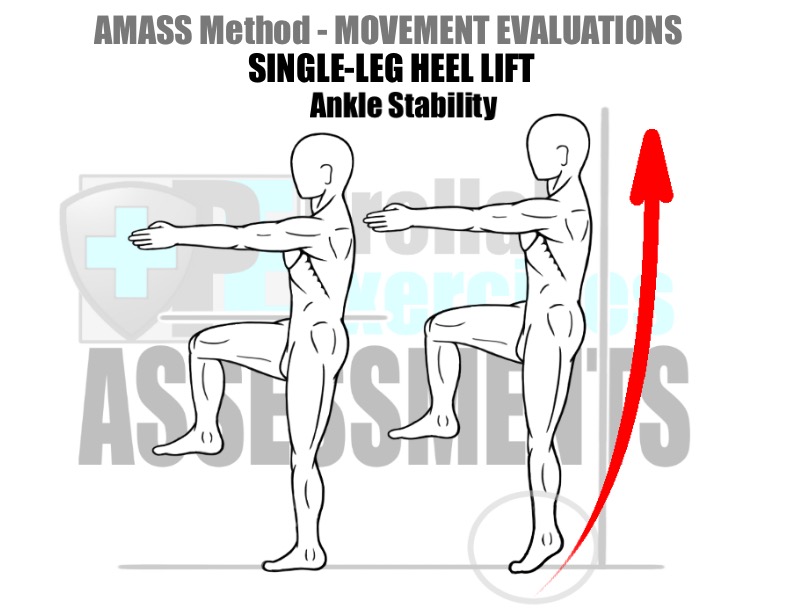
SINGLE-LEG HEEL LIFT
Assess the Range of Motion and Stability of the Foot and Ankle.
ALIGNMENT CUES
• Stand on one leg (Single-Leg) with the opposite Knee tucked to Hip Height and both Arms extended to the horizon, parallel to the floor.
• Lift the standing Heel off the floor while maintaining balance.
• Attempt extend the Ankle into 50º of Plantar Flexion.
• Stand on one leg (Single-Leg) with the opposite Knee tucked to Hip Height and both Arms extended to the horizon, parallel to the floor.
• Lift the standing Heel off the floor while maintaining balance.
• Attempt extend the Ankle into 50º of Plantar Flexion.
PREHAB EXERCISES
• Soft Tissue Therapy (Mobility) for the Foot, Leg, and Hip.
• Stretch (Mobility) the Foot, Ankle, Hip, and Posterior Chain with isolated and Combination Mobility Exercises.
• Activate the Foot, Ankle, Hip, and Posterior Chain Muscles with isolated and Combination Activation Exercises.
• Stabilize the Ankle and Hips with isolated and Combination Exercises.
• Soft Tissue Therapy (Mobility) for the Foot, Leg, and Hip.
• Stretch (Mobility) the Foot, Ankle, Hip, and Posterior Chain with isolated and Combination Mobility Exercises.
• Activate the Foot, Ankle, Hip, and Posterior Chain Muscles with isolated and Combination Activation Exercises.
• Stabilize the Ankle and Hips with isolated and Combination Exercises.
Start with Mobility exercises and progress to Activation and Stability exercises if the individual fails to exhibit an adequate amount of Stability.
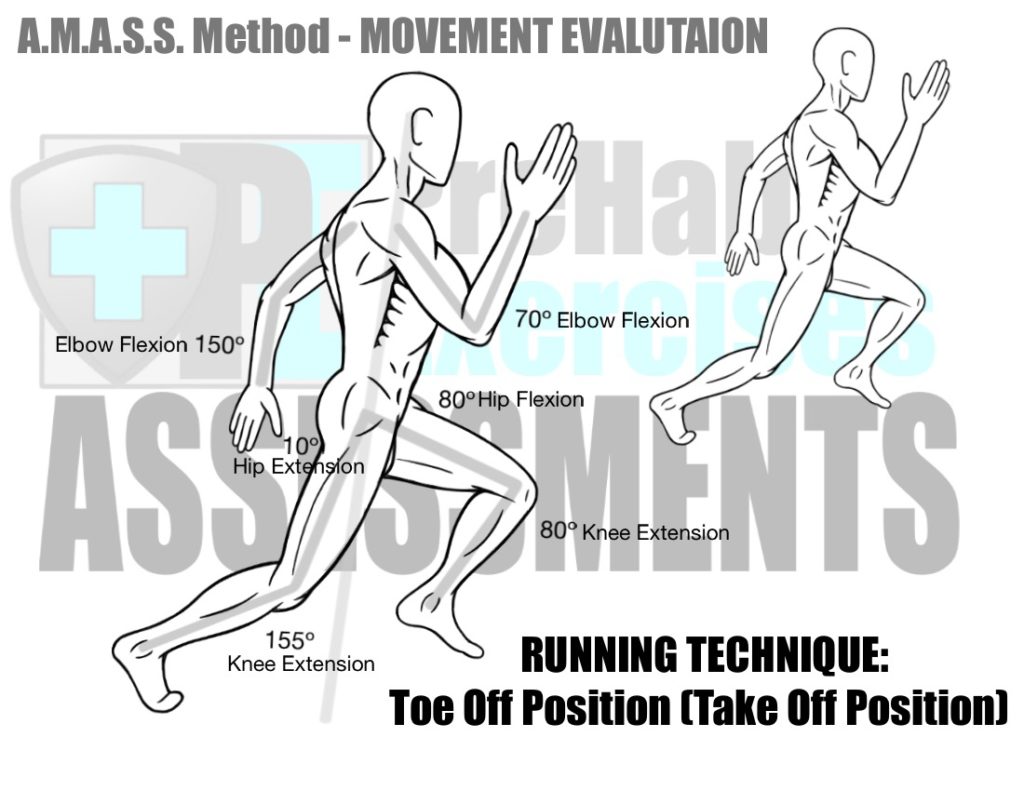
Running Technique: TOE-OFF POSITION
Assess the Runner’s Alignment in the Toe-Off Position.
Toe-Off Position: the point where the Back Foot is making final contact with the ground.
ALIGNMENT CUES
• Front Arm: Elbow is approximately flexed (bent) to 70º and makes a ‘short lever arm’ in regards to the distance of the hand from the mid-line of the body (Spine), which decreases any braking momentum in the stride.
• Back Arm: Elbow approximately extends to 155º and makes a ‘long lever arm,’ which helps shuttle kinetic energy backwards to propel the runner forward.
• Hip Extension of the ‘Stance’ Leg (Back Leg) should approximately open to 10º of extension, which lengthens the stride and drives the runner forward.
• Knee Extension of the ‘Stance’ Leg (Back Leg) should approximately open to 150º of extension.
• Hip Flexion of the ‘Recovery’ Leg (Front Leg) should approximately open to 80º and create a relatively ‘short lever arm’ of the Front Leg in relation to the midline of the body, which helps reduce the braking forces in the stride.
• Knee Flexion of the ‘Recovery’ Leg (Front Leg) should approximately open to 80º to create the mechanically desired ‘short lever arm’ of the front leg.
• Front Arm: Elbow is approximately flexed (bent) to 70º and makes a ‘short lever arm’ in regards to the distance of the hand from the mid-line of the body (Spine), which decreases any braking momentum in the stride.
• Back Arm: Elbow approximately extends to 155º and makes a ‘long lever arm,’ which helps shuttle kinetic energy backwards to propel the runner forward.
• Hip Extension of the ‘Stance’ Leg (Back Leg) should approximately open to 10º of extension, which lengthens the stride and drives the runner forward.
• Knee Extension of the ‘Stance’ Leg (Back Leg) should approximately open to 150º of extension.
• Hip Flexion of the ‘Recovery’ Leg (Front Leg) should approximately open to 80º and create a relatively ‘short lever arm’ of the Front Leg in relation to the midline of the body, which helps reduce the braking forces in the stride.
• Knee Flexion of the ‘Recovery’ Leg (Front Leg) should approximately open to 80º to create the mechanically desired ‘short lever arm’ of the front leg.
PREHAB EXERCISES
• Soft Tissue Therapy (Mobility) for the Foot, Leg, and Hip.
• Stretch (Mobility) the Foot, Ankle, Hip, and Posterior Chain with isolated and Combination Mobility Exercises.
• Activate the Foot, Ankle, Hip, and Posterior Chain Muscles with isolated and Combination Activation Exercises.
• Stabilize the Ankle and Hips with isolated and Combination Exercises.
• Strengthen the body to develop the amount of force needed to push the ground backwards and drive through the ‘Toe-Off’ Position.
• Practice the Gait Efficiency and Form Running Drills as well as the Forward Lean exercises to develop the ‘skill’ to continuously achieve optimal alignment of this Toe-Off Position.
• Soft Tissue Therapy (Mobility) for the Foot, Leg, and Hip.
• Stretch (Mobility) the Foot, Ankle, Hip, and Posterior Chain with isolated and Combination Mobility Exercises.
• Activate the Foot, Ankle, Hip, and Posterior Chain Muscles with isolated and Combination Activation Exercises.
• Stabilize the Ankle and Hips with isolated and Combination Exercises.
• Strengthen the body to develop the amount of force needed to push the ground backwards and drive through the ‘Toe-Off’ Position.
• Practice the Gait Efficiency and Form Running Drills as well as the Forward Lean exercises to develop the ‘skill’ to continuously achieve optimal alignment of this Toe-Off Position.
Start with Mobility exercises and progress through Activation, Stability, and Strength exercises as part of PreHab and training. Then practice both the Gait Efficiency and Form Running Drills to improve Running Technique.
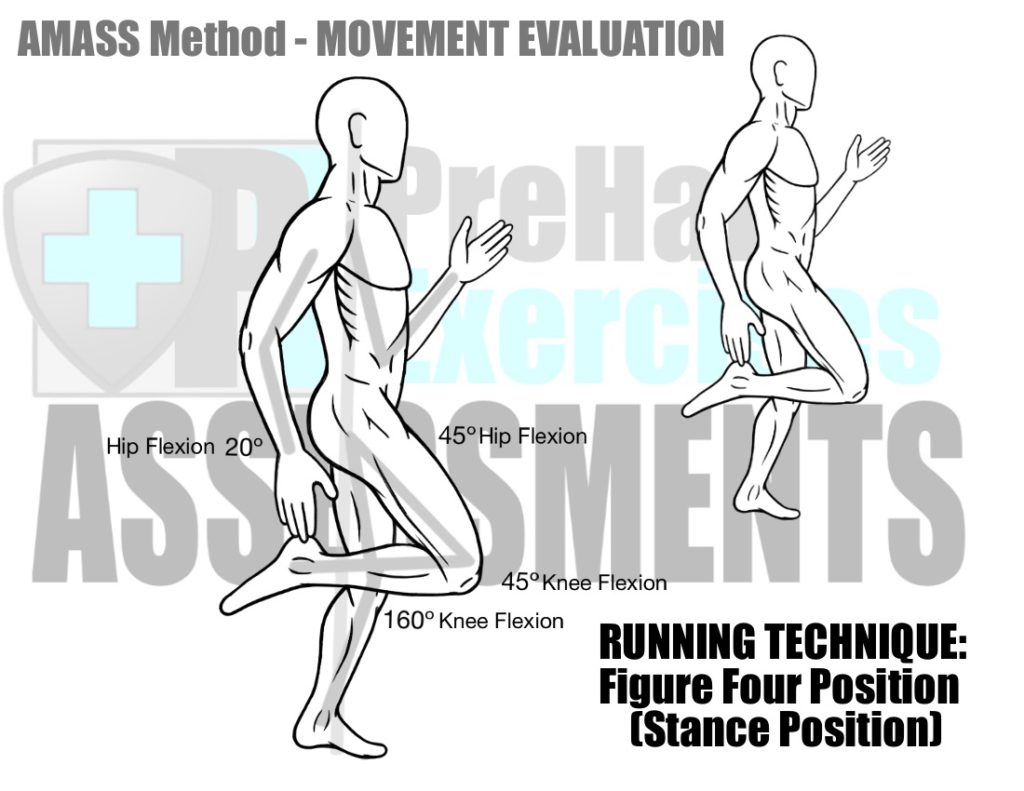
Running Technique: FIGURE-FOUR POSITION
Assess the Runner’s Alignment in the Figure-Four or Stance Position.
Figure-Four Position is the position where the Stance Foot bears all the weight and completely supports the body.
ALIGNMENT CUES
• Hip Extension of the ‘Stance’ Leg (Back Leg) should approximately open to <20º of extension, which offers the optimal ‘Length-Tension Relationship’ of the Hip and Leg muscles. • Knee Extension of the ‘Stance’ Leg (Back Leg) should approximately open to <160º of extension. • Hip Flexion of the ‘Recovery’ Leg (Front Leg) should approximately open to 45º and create a relatively ‘short lever arm’ of the Front Leg in relation to the midline of the body. • Knee Flexion of the ‘Recovery’ Leg (Front Leg) should approximately open to 40º to create a ‘short lever arm’ of the front leg and allow for a fast turn-over in the stride. • Midline of the body should align over the ‘Stance’ Foot. Many times, an individual will strike the ground with the heel in front of the midline, which creates a ‘braking’ force and slows the runner. PREHAB EXERCISES
• Soft Tissue Therapy (Mobility) for the Foot, Leg, and Hip.
• Stretch (Mobility) the Foot, Ankle, Hip, and Posterior Chain with isolated and Combination Mobility Exercises.
• Activate the Foot, Ankle, Hip, and Posterior Chain Muscles with isolated and Combination Activation Exercises.
• Stabilize the Ankle and Hips with isolated and Combination Exercises.
• Strengthen the body so it has the ability maintain ideal alignment while supporting the body over top of one foot. Keep in mind that the downward force on the stance leg can equal 2x bodyweight while jogging and up to 6x bodyweight while sprinting.
• Practice the Gait Efficiency and Form Running Drills, as well as the Forward Lean exercises to develop the ‘skill’ to achieve the optimal alignment of this Figure-Four Position and reduce the likelihood of running with a Heel Strike.
• Hip Extension of the ‘Stance’ Leg (Back Leg) should approximately open to <20º of extension, which offers the optimal ‘Length-Tension Relationship’ of the Hip and Leg muscles. • Knee Extension of the ‘Stance’ Leg (Back Leg) should approximately open to <160º of extension. • Hip Flexion of the ‘Recovery’ Leg (Front Leg) should approximately open to 45º and create a relatively ‘short lever arm’ of the Front Leg in relation to the midline of the body. • Knee Flexion of the ‘Recovery’ Leg (Front Leg) should approximately open to 40º to create a ‘short lever arm’ of the front leg and allow for a fast turn-over in the stride. • Midline of the body should align over the ‘Stance’ Foot. Many times, an individual will strike the ground with the heel in front of the midline, which creates a ‘braking’ force and slows the runner. PREHAB EXERCISES
• Soft Tissue Therapy (Mobility) for the Foot, Leg, and Hip.
• Stretch (Mobility) the Foot, Ankle, Hip, and Posterior Chain with isolated and Combination Mobility Exercises.
• Activate the Foot, Ankle, Hip, and Posterior Chain Muscles with isolated and Combination Activation Exercises.
• Stabilize the Ankle and Hips with isolated and Combination Exercises.
• Strengthen the body so it has the ability maintain ideal alignment while supporting the body over top of one foot. Keep in mind that the downward force on the stance leg can equal 2x bodyweight while jogging and up to 6x bodyweight while sprinting.
• Practice the Gait Efficiency and Form Running Drills, as well as the Forward Lean exercises to develop the ‘skill’ to achieve the optimal alignment of this Figure-Four Position and reduce the likelihood of running with a Heel Strike.
Start with Mobility exercises and progress through Activation, Stability, and Strength exercises as part of PreHab and training. Then practice both the Gait Efficiency and Form Running Drills to improve Running Technique.
RECAP: The A.M.A.S.S. Method of PreHab
A simple method of creating an effective PreHab Program that keeps individuals running longer, further, and faster.
A simple method of creating an effective PreHab Program that keeps individuals running longer, further, and faster.
ASSESS
First, use Basic Assessments, Movement Evaluations, and Observations to assess the Biomechanical Efficiency and Movement Quality of the individual.
Discover the necessary areas of focus for PreHab.
First, use Basic Assessments, Movement Evaluations, and Observations to assess the Biomechanical Efficiency and Movement Quality of the individual.
Discover the necessary areas of focus for PreHab.
MOBILIZE
Next, use Soft Tissue Therapy and various Stretching techniques to improve Mobility.
Work to improve the individual’s Flexibility, Alignment, and Range of Motion.
Next, use Soft Tissue Therapy and various Stretching techniques to improve Mobility.
Work to improve the individual’s Flexibility, Alignment, and Range of Motion.
ACTIVATE
Then, use various exercises to stimulate specific Neuromuscular Connections and
Activate targeted Muscle Groups essential to executing Movement Patterns with proper form and alignment.
Then, use various exercises to stimulate specific Neuromuscular Connections and
Activate targeted Muscle Groups essential to executing Movement Patterns with proper form and alignment.
STABILIZE
After accomplishing the previous steps, use various exercises and increased sets/reps/load schemes to challenge the Neuromuscular System to improve Balance, Coordination, and Body Control.
After accomplishing the previous steps, use various exercises and increased sets/reps/load schemes to challenge the Neuromuscular System to improve Balance, Coordination, and Body Control.
STRENGTHEN
Finally, further enhance the individual’s ‘ability’ to produce, absorb, and resist Force by developing Strength in various Movement Patterns and through a full Range of Motion.
Finally, further enhance the individual’s ‘ability’ to produce, absorb, and resist Force by developing Strength in various Movement Patterns and through a full Range of Motion.
PreHab. Run. Recover.
(Repeat)
(Repeat)
PreHab Exercise Diagrams – Soft Tissue Therapy – Region By Region
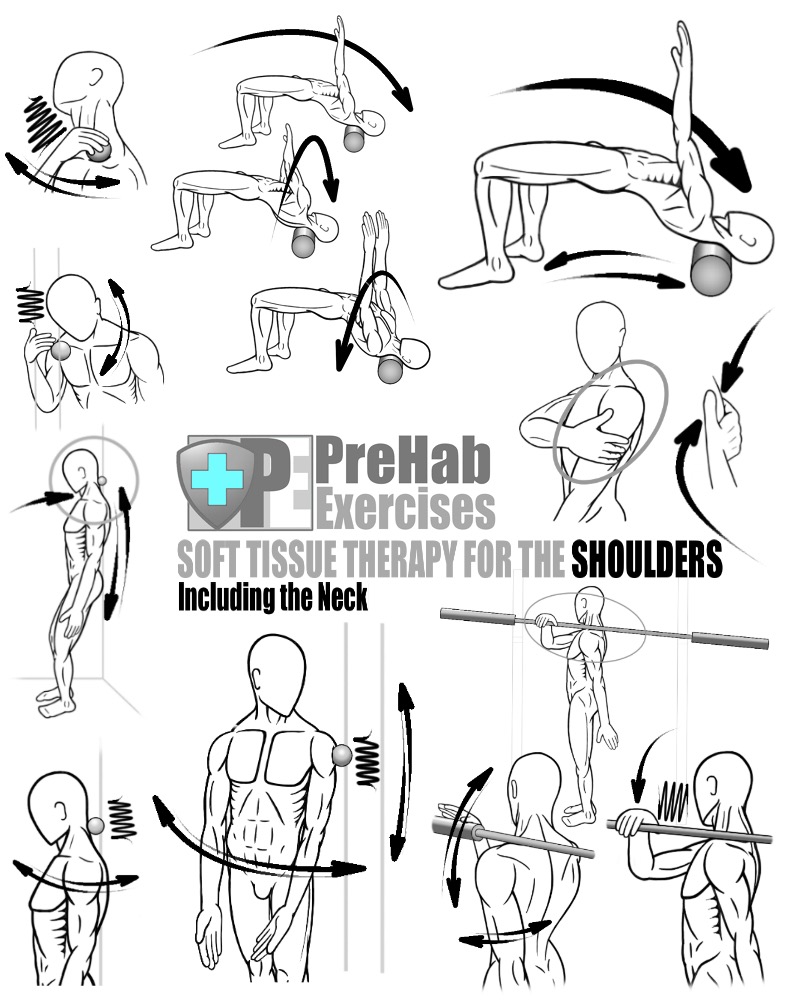
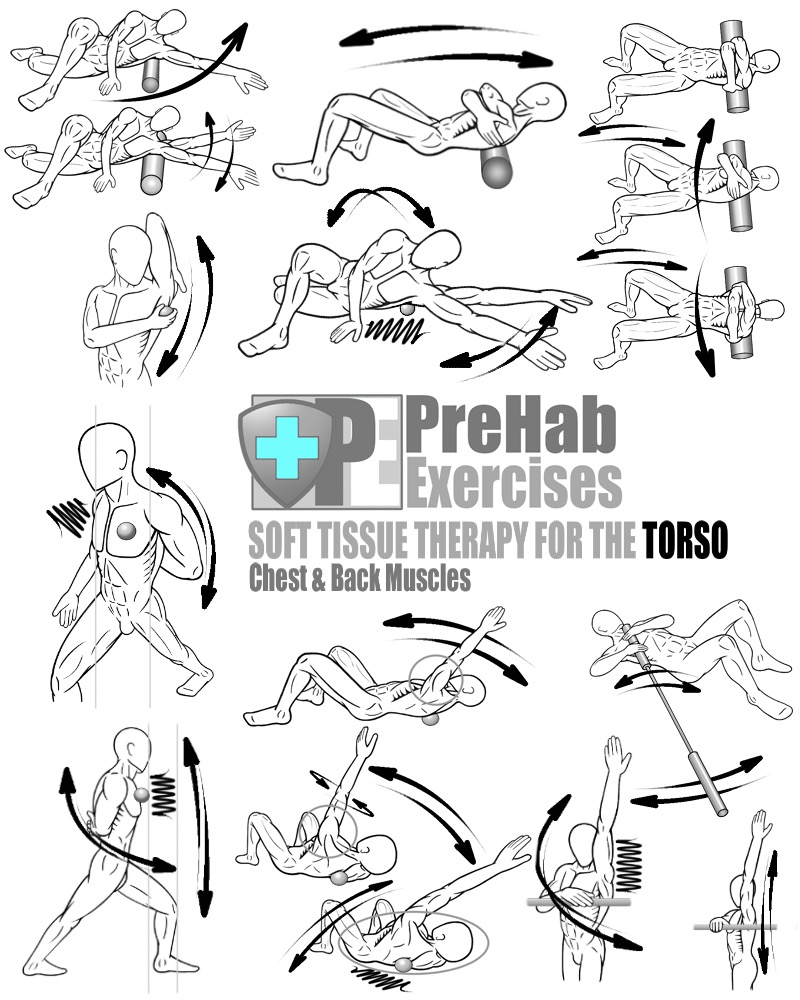
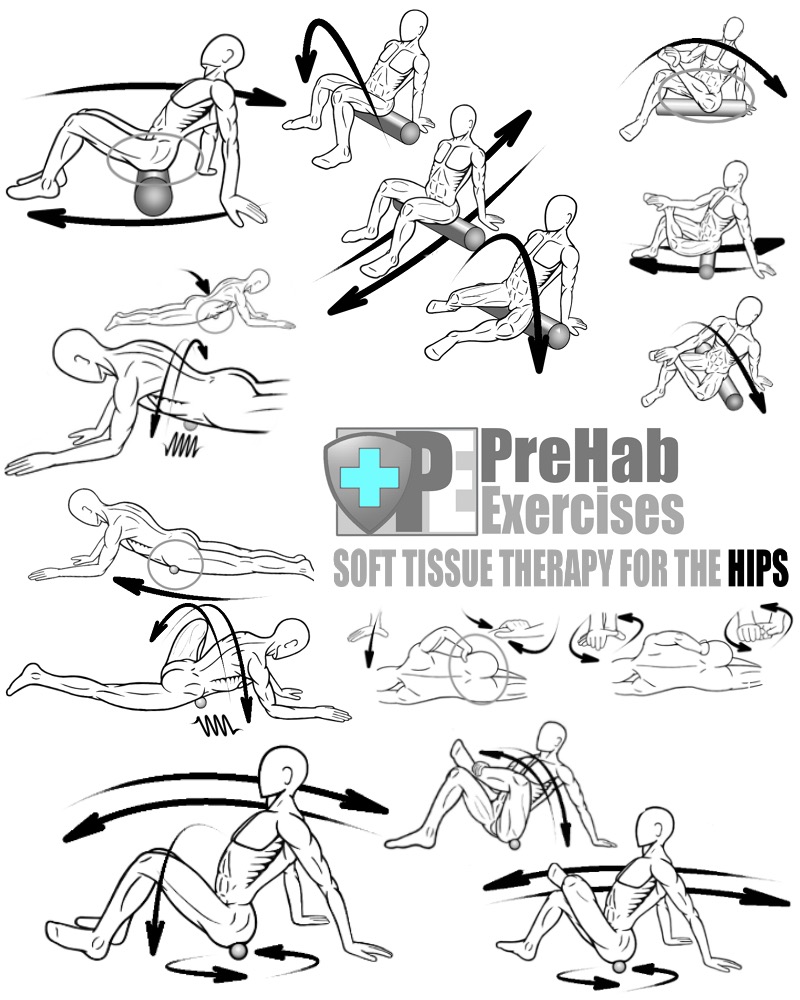
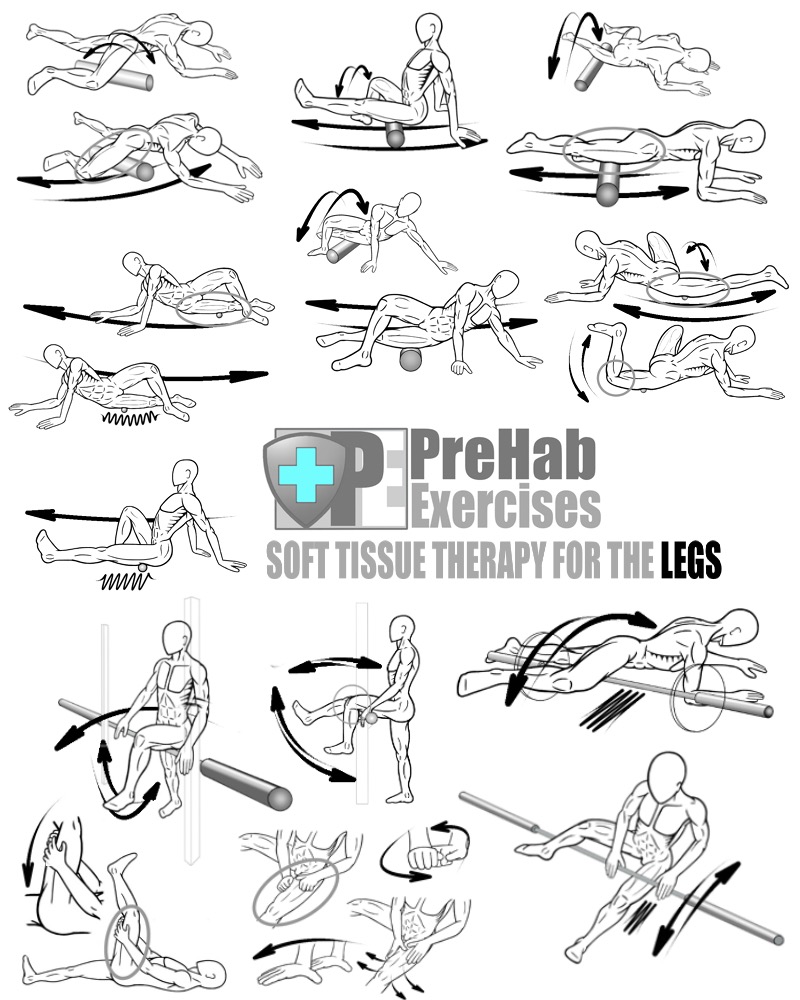
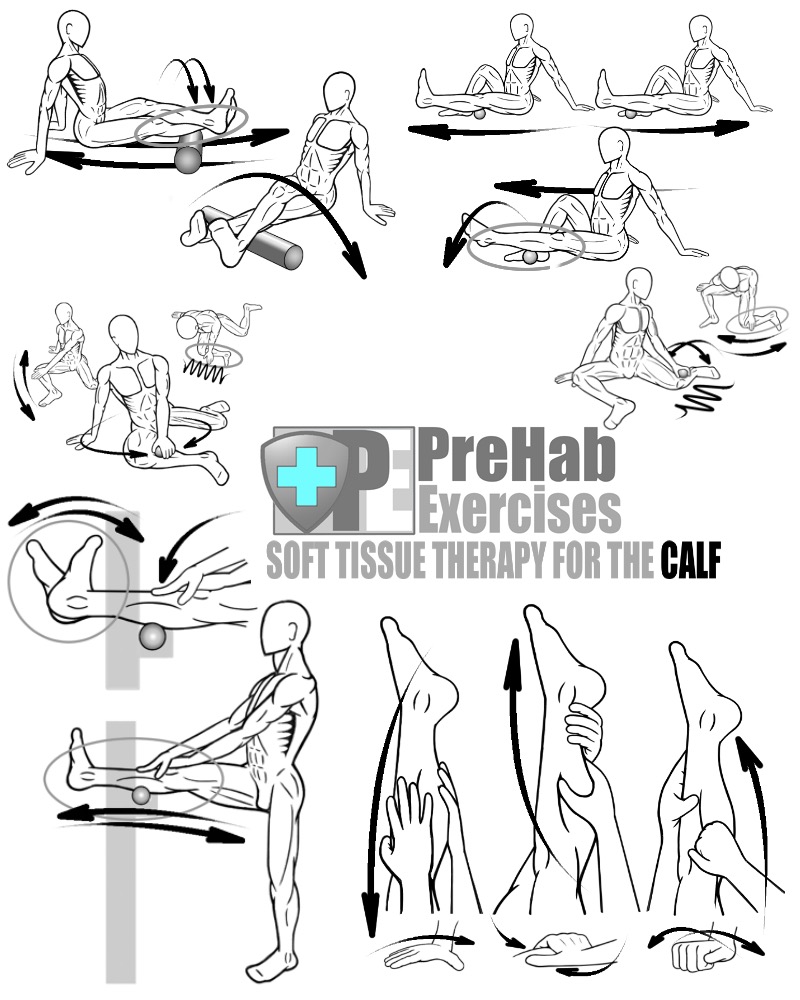
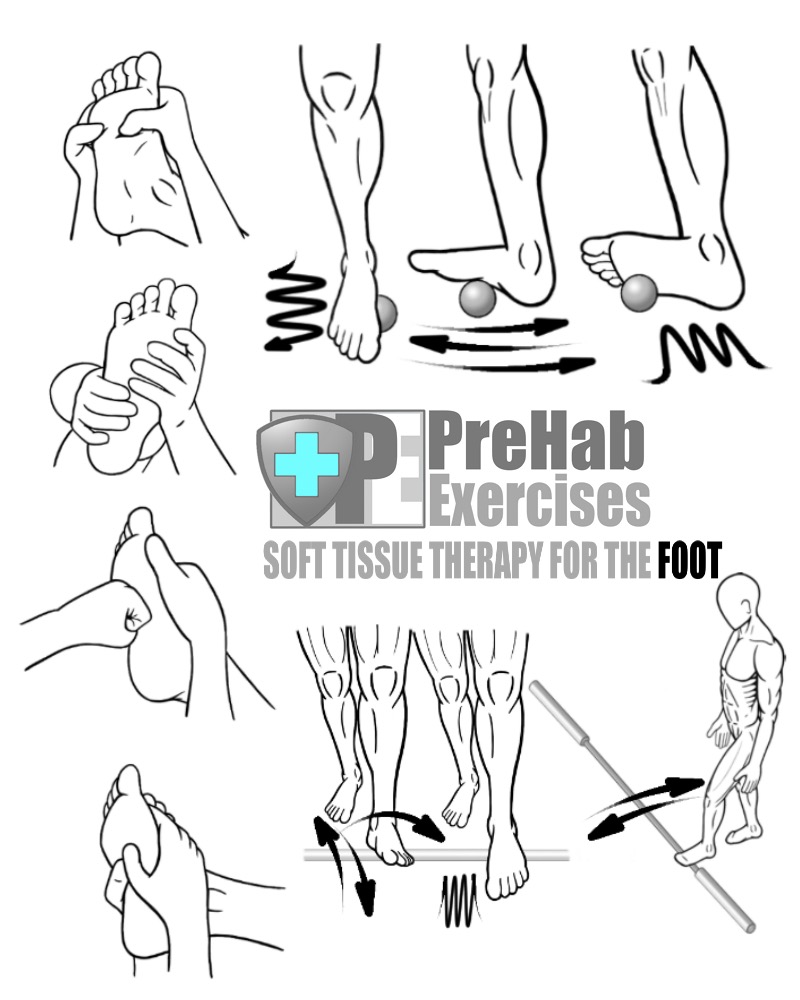
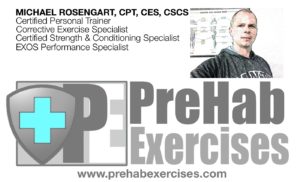
Комментариев нет:
Отправить комментарий